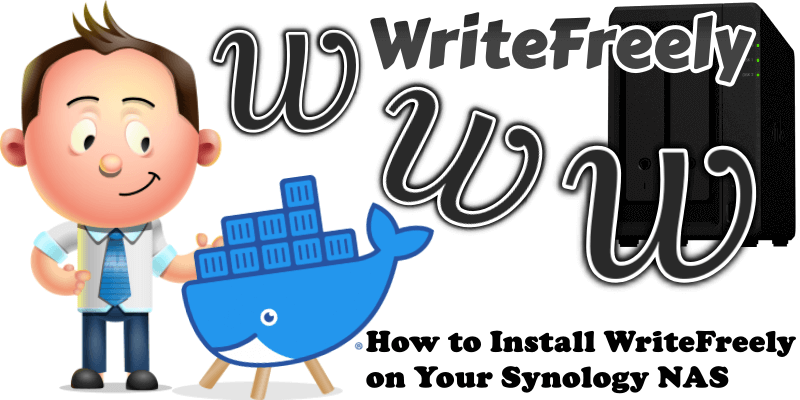
WriteFreely is a clean, minimalist publishing platform made for writers. Start a blog, share knowledge within your organization, or build a community around the shared act of writing. WriteFreely supports federation via ActivityPub, a protocol spoken by popular platforms like Mastodon and Pixelfed. This means that other people can directly follow your blog from the decentralized social network known as the “fediverse”, if your WriteFreely admin has enabled federation (STEP 34). In this step by step guide I will show you how to install WriteFreely on your Synology NAS using Docker and Portainer. Note: The guide proposed below is using MySQL as database, but if you want to use SQLite as database, just follow my guide on How to Install WriteFreely SQLite on Your Synology NAS.
This guide works perfectly with the latest WriteFreely v0.15.1 release.
STEP 1
Please Support My work by Making a Donation.
STEP 2
Install Portainer using my step by step guide. If you already have Portainer installed on your Synology NAS, skip this STEP. Attention: Make sure you have installed the latest Portainer version.
STEP 3
Make sure you have a synology.me Wildcard Certificate. Follow my guide to get a Wildcard Certificate. If you already have a synology.me Wildcard certificate, skip this STEP.
STEP 4
Install Text Editor via Synology “Package Center”. (Mandatory STEP.) If you already have Text Editor installed on your Synology NAS, skip this STEP.
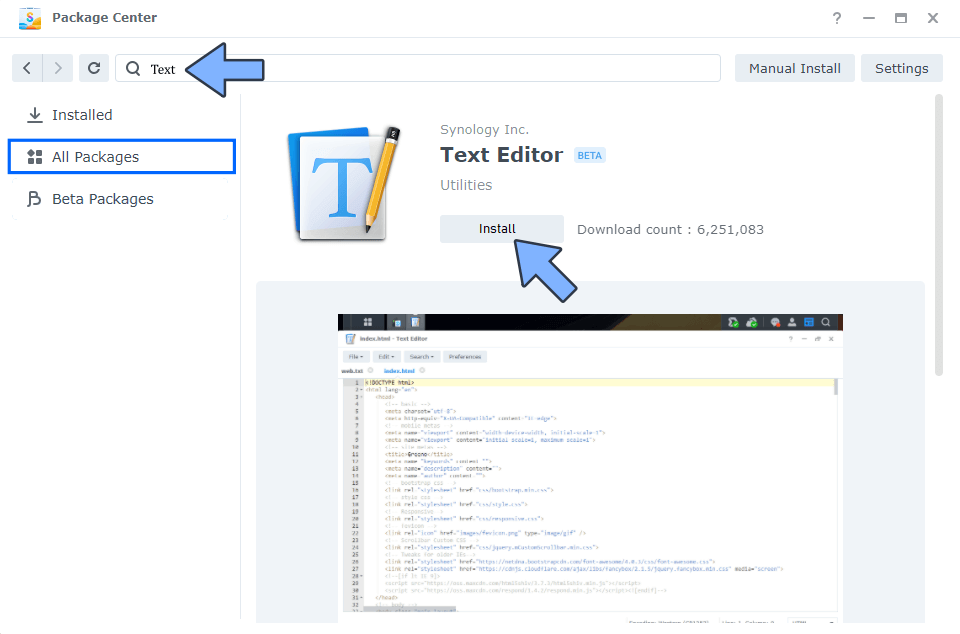
STEP 5
Go to Control Panel / Login Portal / Advanced Tab / click Reverse Proxy. Follow the instructions in the image below.
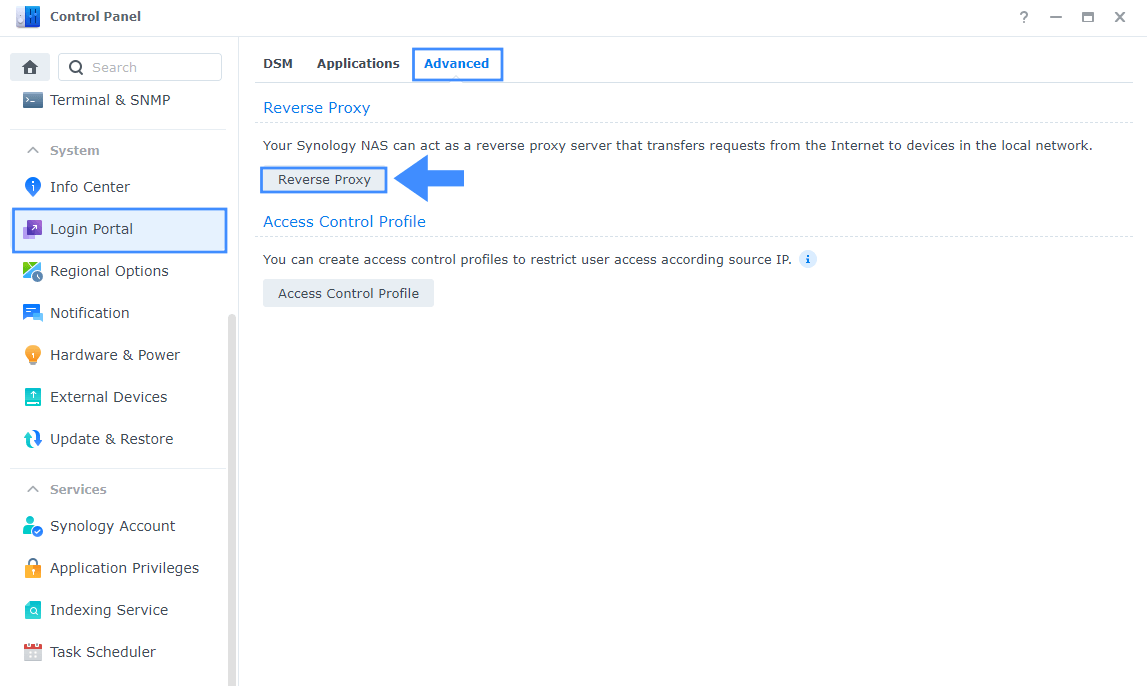
STEP 6
Now click the “Create” button. Follow the instructions in the image below.
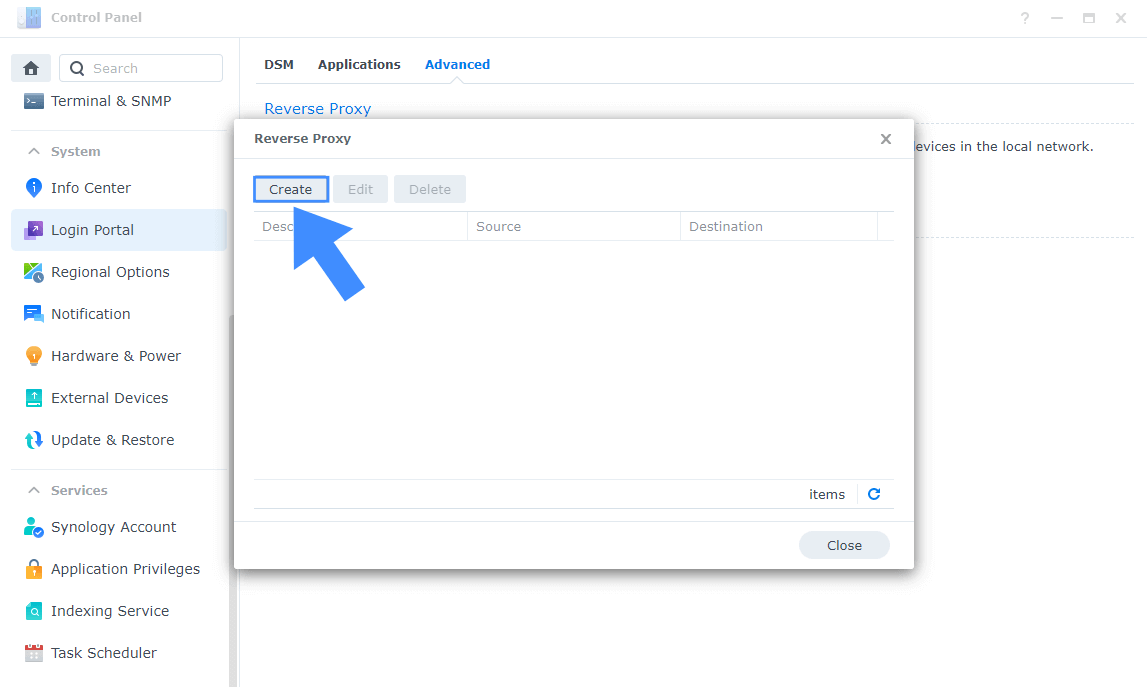
STEP 7
After you click the Create button, the window below will open. Follow the instructions in the image below.
On the General area, set the Reverse Proxy Name description: type in WriteFreely. After that, add the following instructions:
Source:
Protocol: HTTPS
Hostname: writefreely.yourname.synology.me
Port: 443
Check Enable HSTS
Destination:
Protocol: HTTP
Hostname: localhost
Port: 9800
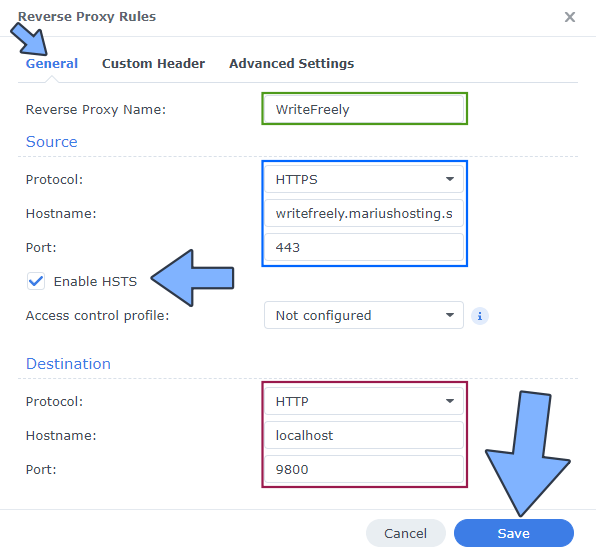
STEP 8
On the Reverse Proxy Rules click the Custom Header tab. Click Create and then, from the drop-down menu, click WebSocket. After you click on WebSocket, two Header Names and two Values will be automatically added. Click Save. Follow the instructions in the image below.

STEP 9
Go to Control Panel / Network / Connectivity tab/ Check Enable HTTP/2 then click Apply. Follow the instructions in the image below.
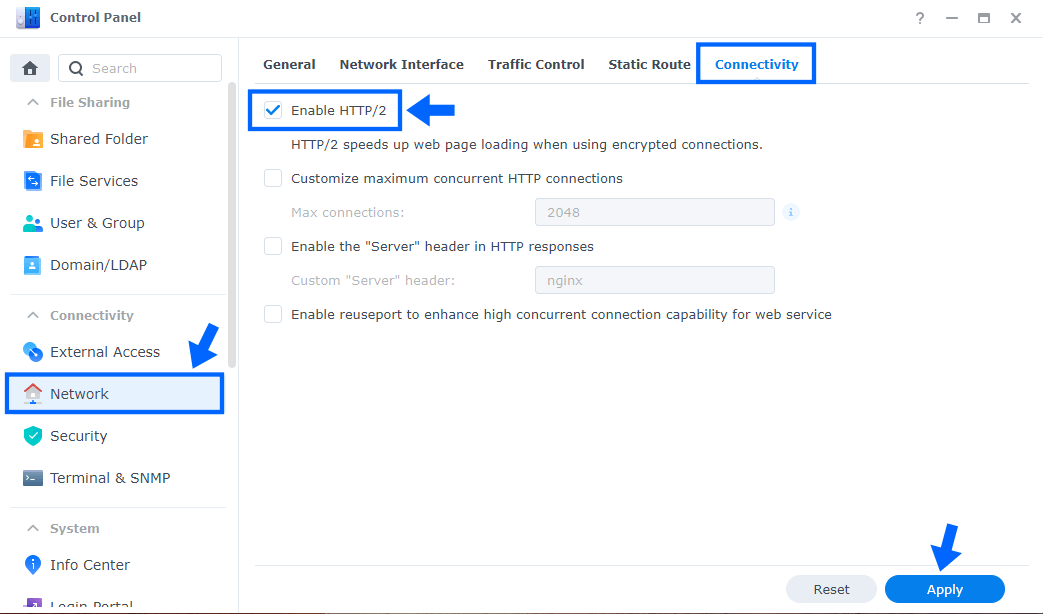
STEP 10
Go to Control Panel / Security / Advanced tab/ Check Enable HTTP Compression then click Apply. Follow the instructions in the image below.
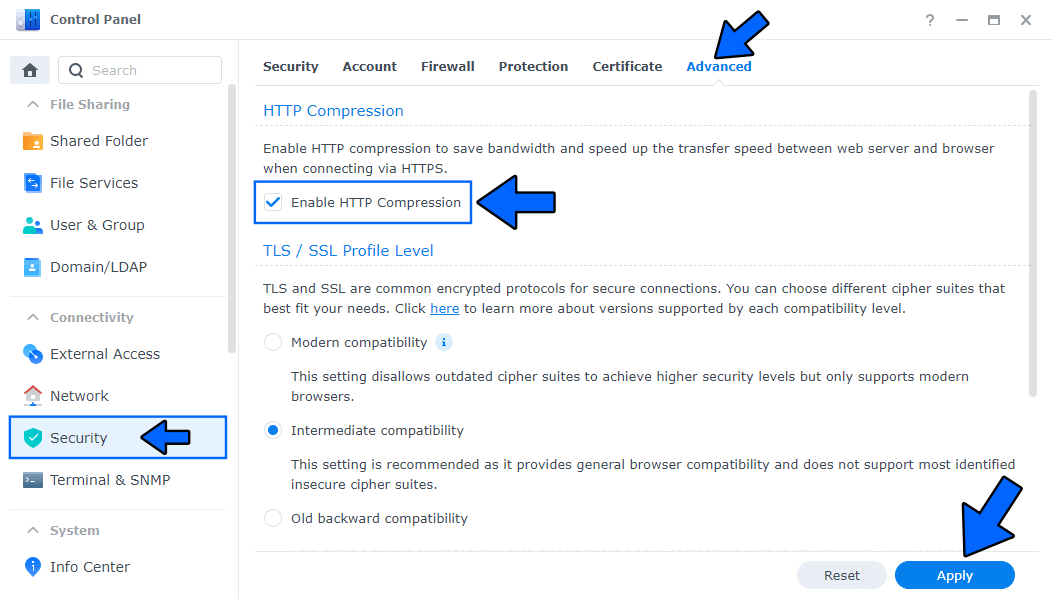
STEP 11
Go to File Station and open the docker folder. Inside the docker folder, create one new folder and name it writefreely. Follow the instructions in the image below.
Note: Be careful to enter only lowercase, not uppercase letters.
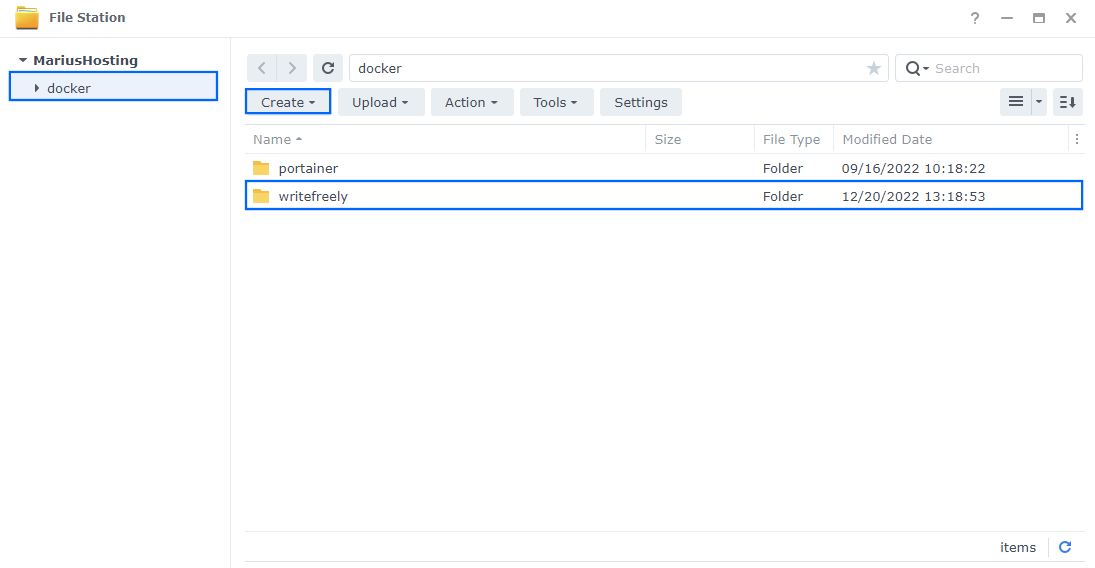
STEP 12
Now create two new folders inside the writefreely folder that you created at STEP 11 and name them data and db. Follow the instructions in the image below.
Note: Be careful to enter only lowercase, not uppercase letters.
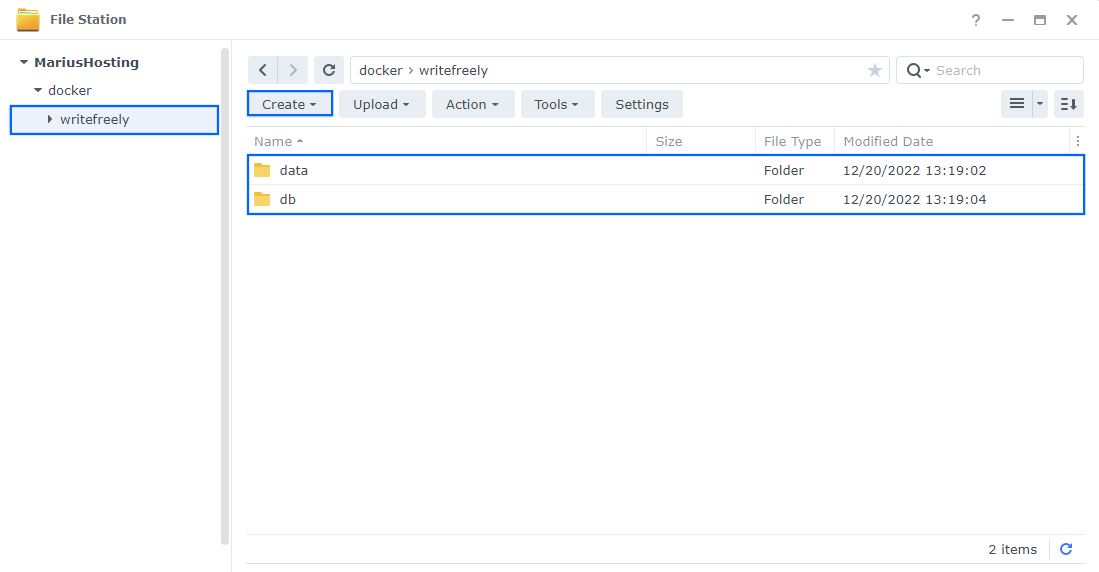
STEP 13
Log into Portainer using your username and password. On the left sidebar in Portainer, click on Stacks then + Add stack. Follow the instructions in the image below.

STEP 14
In the Name field type in writefreely. Follow the instructions in the image below.
services:
db:
image: mariadb:11.4-noble #LTS Long Time Support Until May 29, 2029.
container_name: WriteFreely-db
hostname: writefreely-db
security_opt:
- no-new-privileges:false
environment:
- TZ=Europe/Bucharest
- MYSQL_ROOT_PASSWORD=rootpass
- MYSQL_DATABASE=writefreely
- MYSQL_USER=writefreelyuser
- MYSQL_PASSWORD=writefreelypass
volumes:
- /volume1/docker/writefreely/db:/var/lib/mysql:rw
restart: on-failure:5
writefreely:
image: algernon/writefreely:latest
container_name: WriteFreely
hostname: writefreely
security_opt:
- no-new-privileges:true
user: 1026:100
ports:
- 9800:8080
volumes:
- /volume1/docker/writefreely/data:/data:rw
environment:
- WRITEFREELY_SITE_NAME=Mariushosting blog
- WRITEFREELY_HOST=https://writefreely.yourname.synology.me
restart: on-failure:5
depends_on:
db:
condition: service_started
Note: Before you paste the code above in the Web editor area below, change the value for TZ. (Select your current Time Zone from this list.)
Note: Before you paste the code above in the Web editor area below, change the value numbers for user with your own UID and GID values. (Follow my step by step guide on how to do this.) 1026 is my personal UID value and 100 is my personal GID value. You have to type in your own values.
Note: Before you paste the code above in the Web editor area below, change the value for WRITEFREELY_SITE_NAME and type in your own site name. Mariushosting blog is an example for a site name.
Note: Before you paste the code above in the Web editor area below, change the value for WRITEFREELY_HOST and type in your own synology.me DDNS that you have previously created at STEP 7.
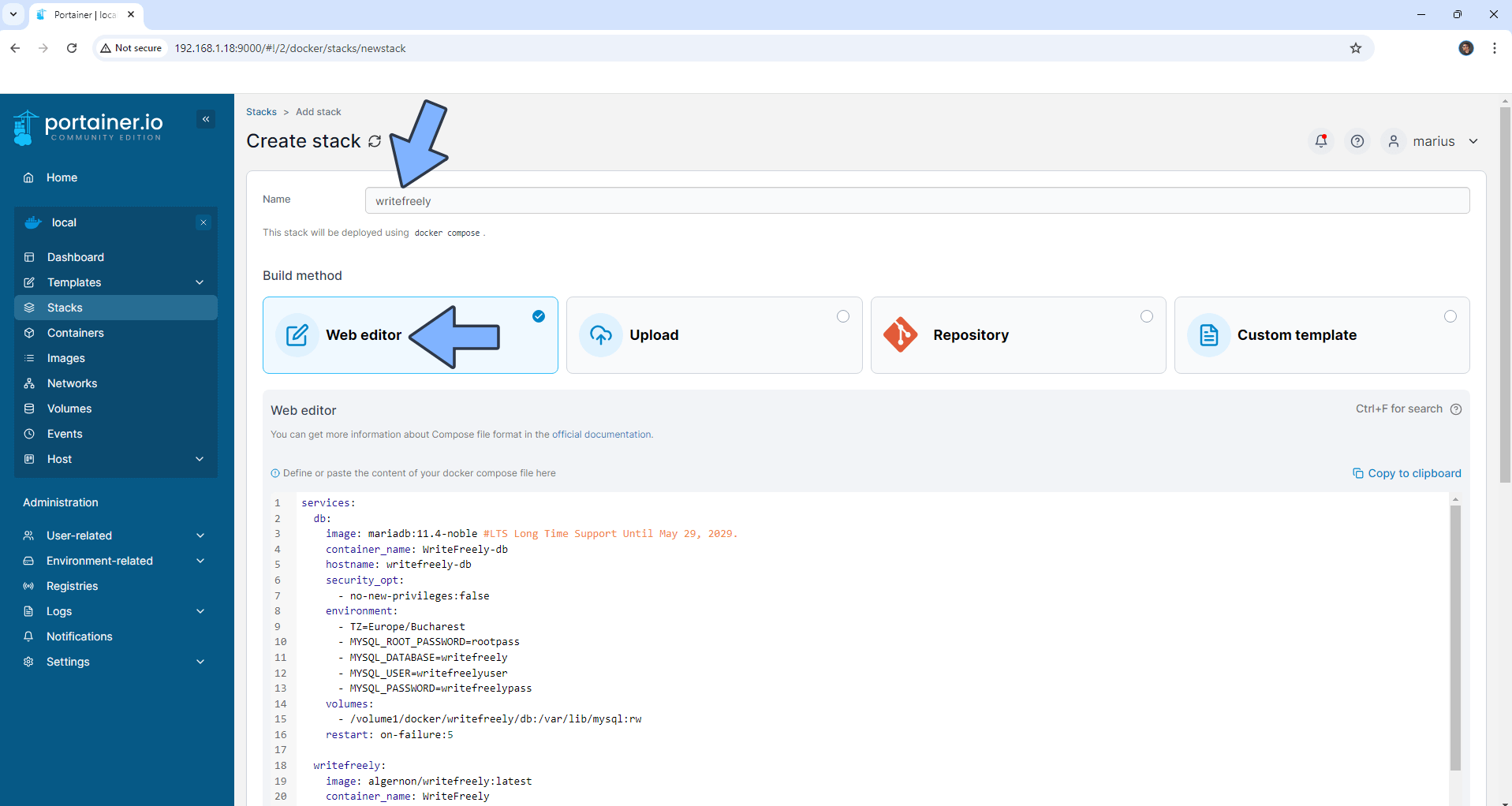
STEP 15
Scroll down on the page until you see a button named Deploy the stack. Click on it. Follow the instructions in the image below. The installation process can take up to a few minutes. It will depend on your Internet speed connection.
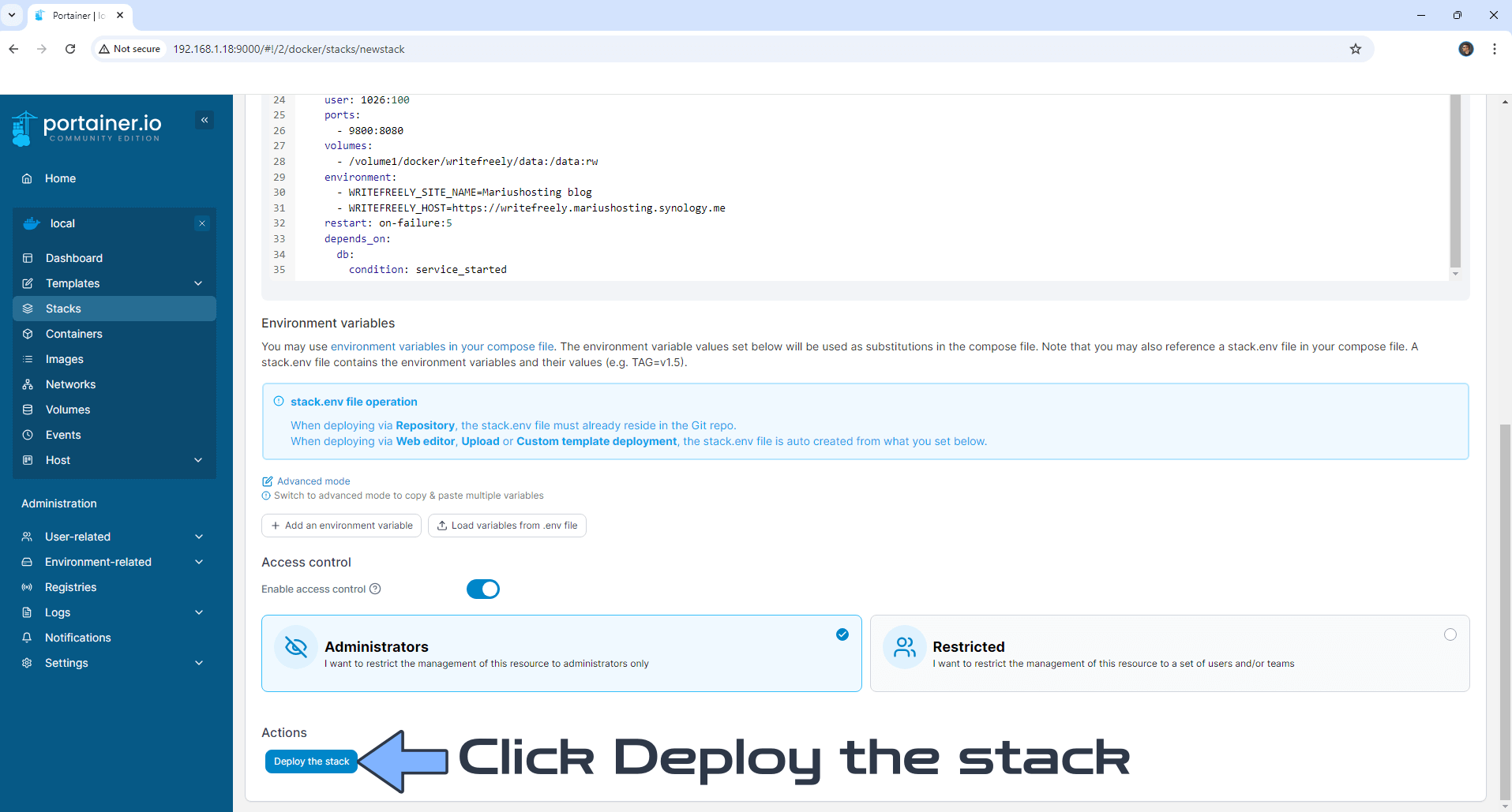
STEP 16
If everything goes right, you will see the following message at the top right of your screen: “Success Stack successfully deployed“.
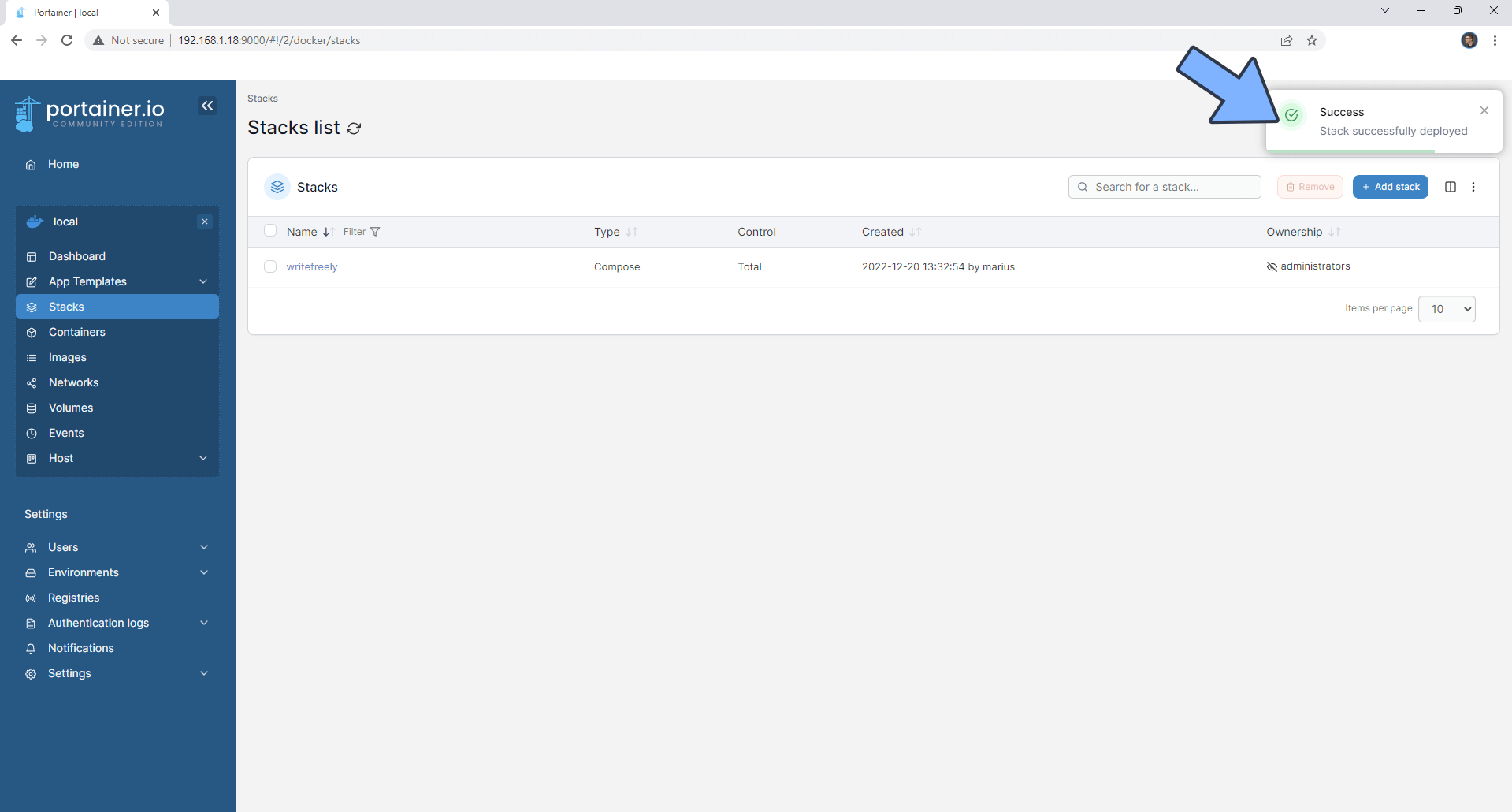
STEP 17
On the left sidebar in Portainer, click Containers. Identify your WriteFreely instance, then click on the little terminal icon. Follow the instructions in the image below.
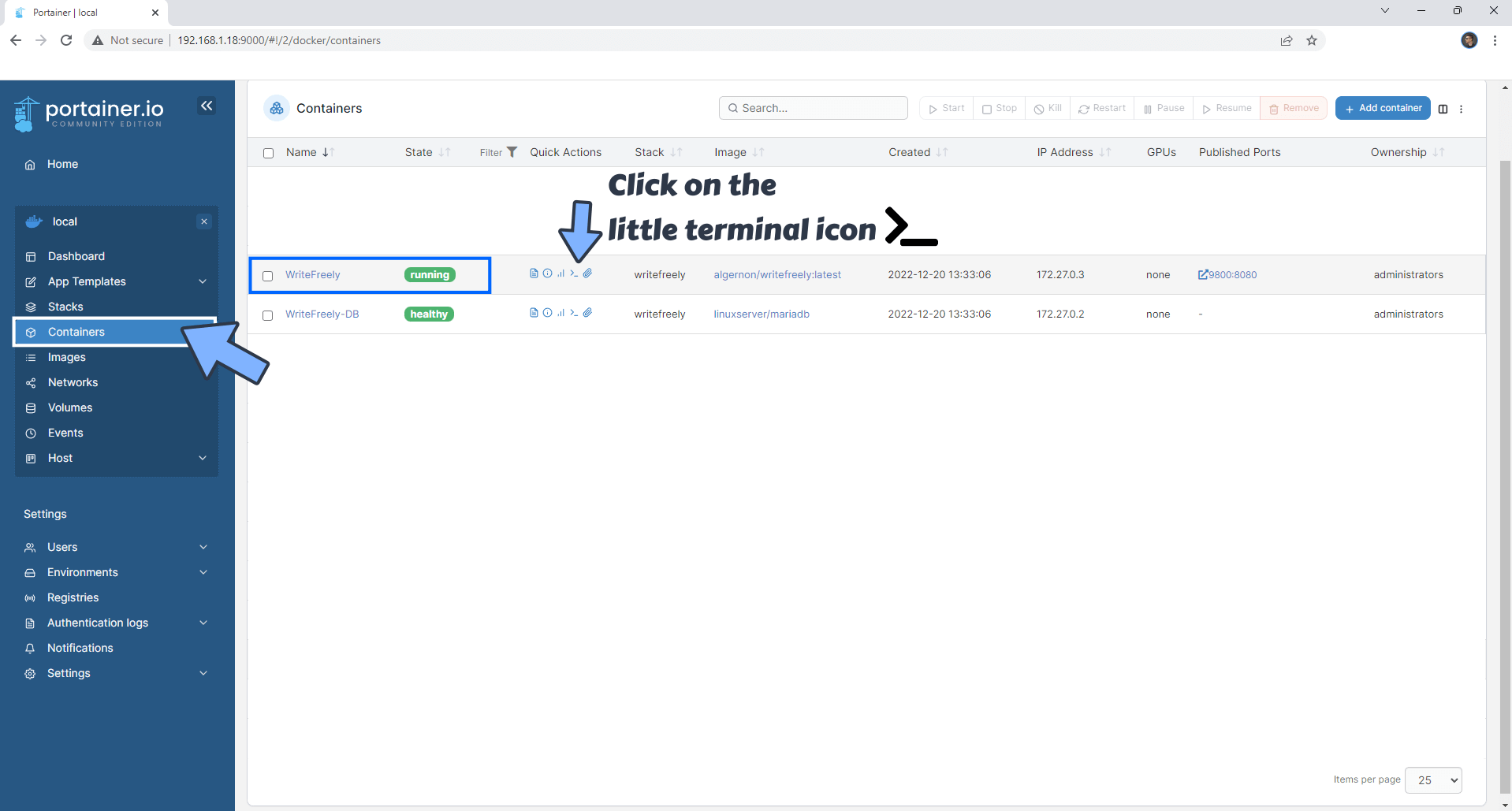
STEP 18
After you click on the little terminal icon at STEP 17, a new page will open. From the Command dropdown menu select /bin/sh then click Connect. Follow the instructions in the image below.
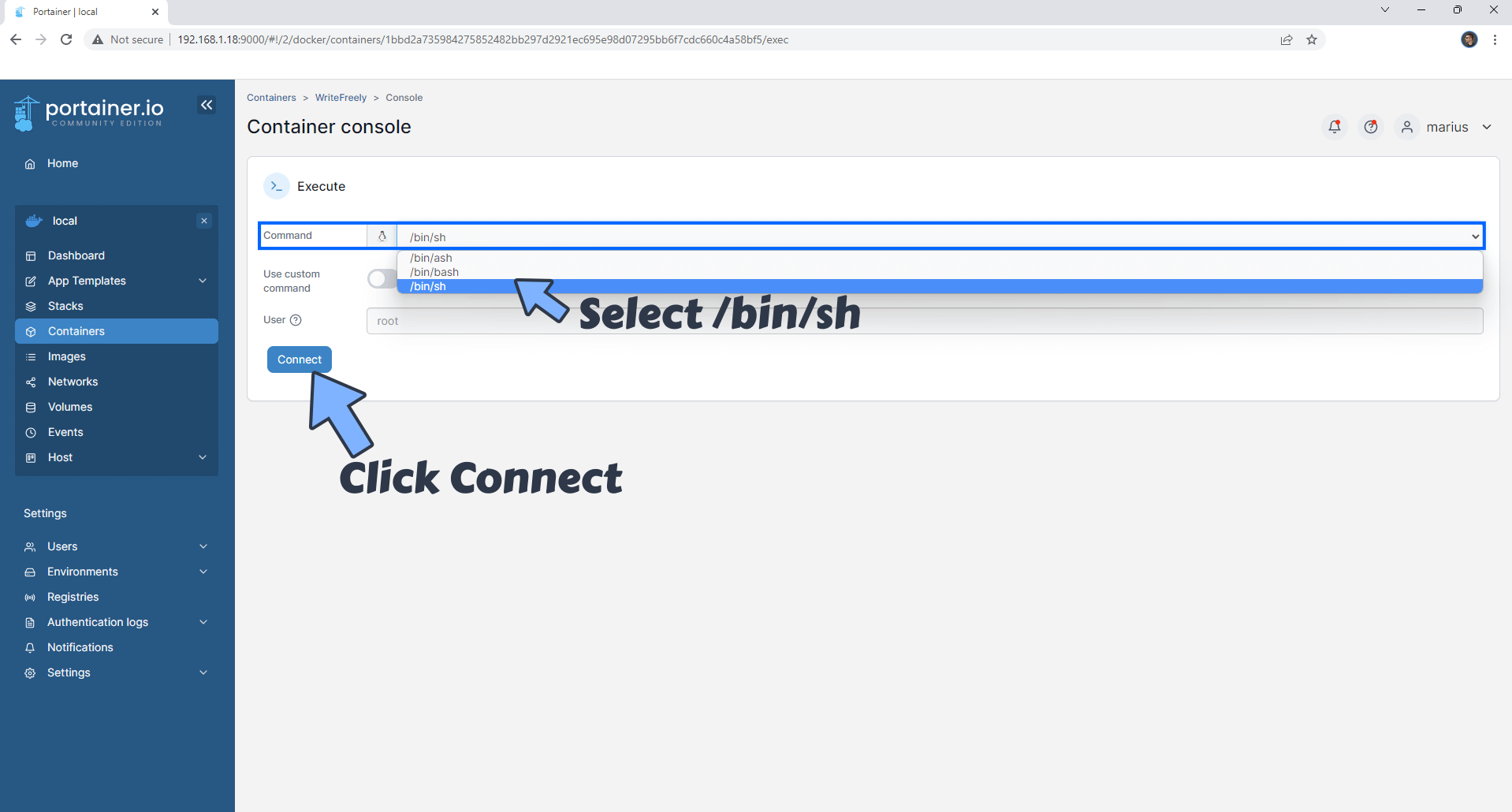
STEP 19
After you click Connect at STEP 18, a Console will open. Type in the text below. Confirm by pressing Enter on your keyboard. Follow the instructions in the image below.
cd /data

STEP 20
After pressing enter at STEP 19, type in the text below. Confirm by pressing Enter on your keyboard. Follow the instructions in the image below.
/writefreely/writefreely --config
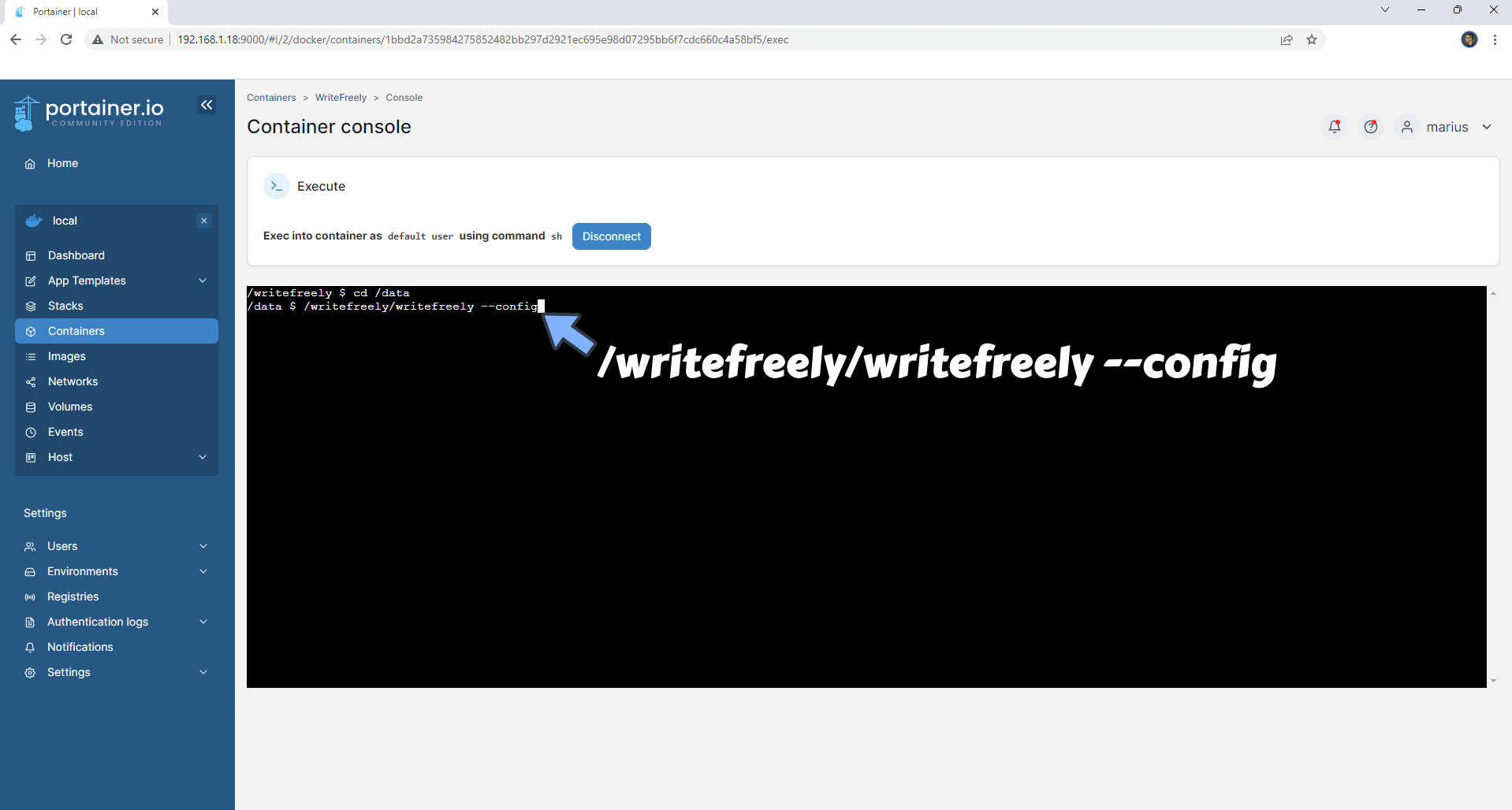
STEP 21
Using the arrow keys on your keyboard select “Production, behind reverse proxy” then confirm by pressing Enter on your keyboard. Follow the instructions in the image below.
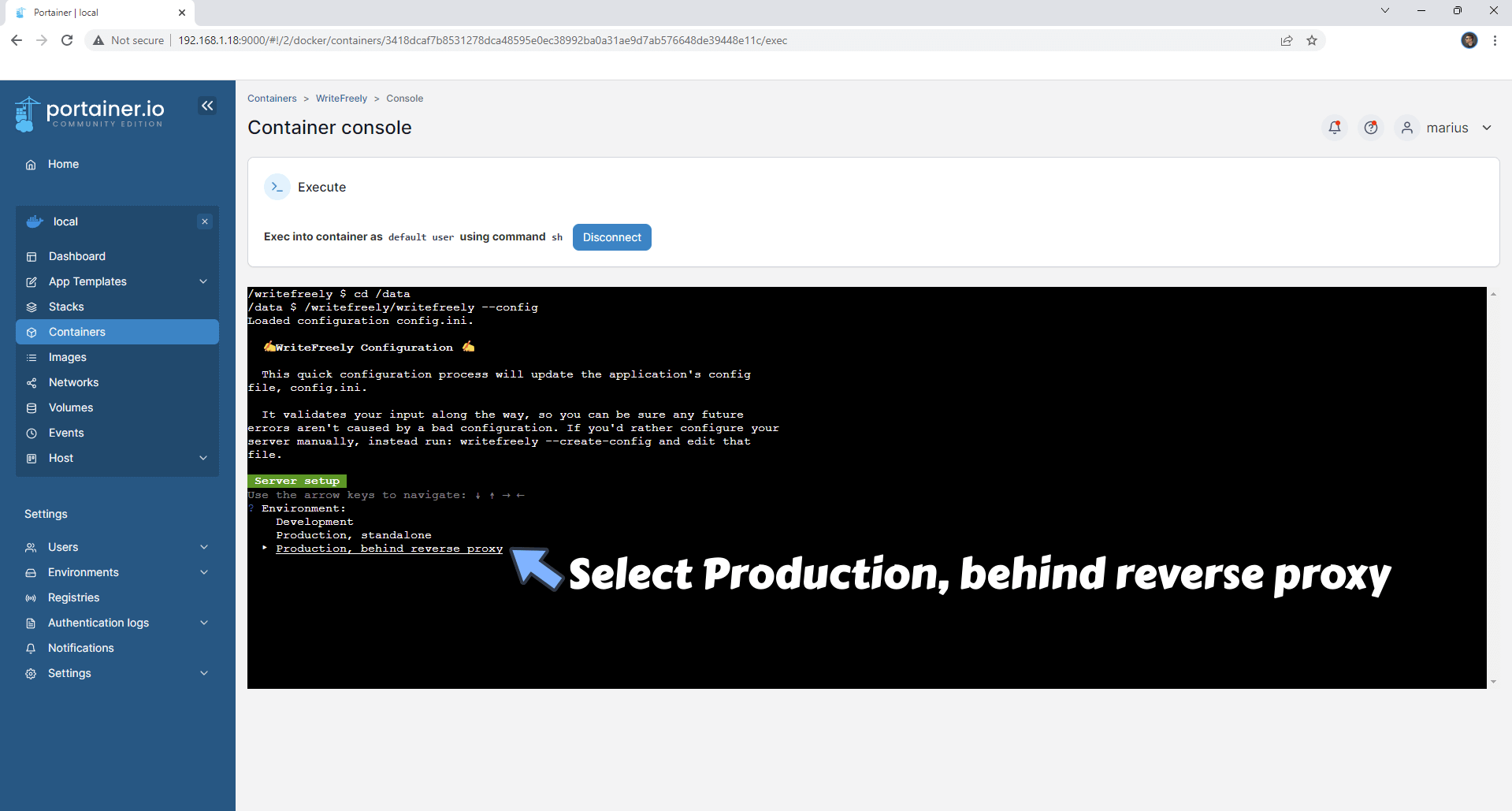
STEP 22
After Selecting Production, behind reverse proxy at STEP 21, type in the text below. Confirm by pressing Enter on your keyboard. Follow the instructions in the image below.
8080
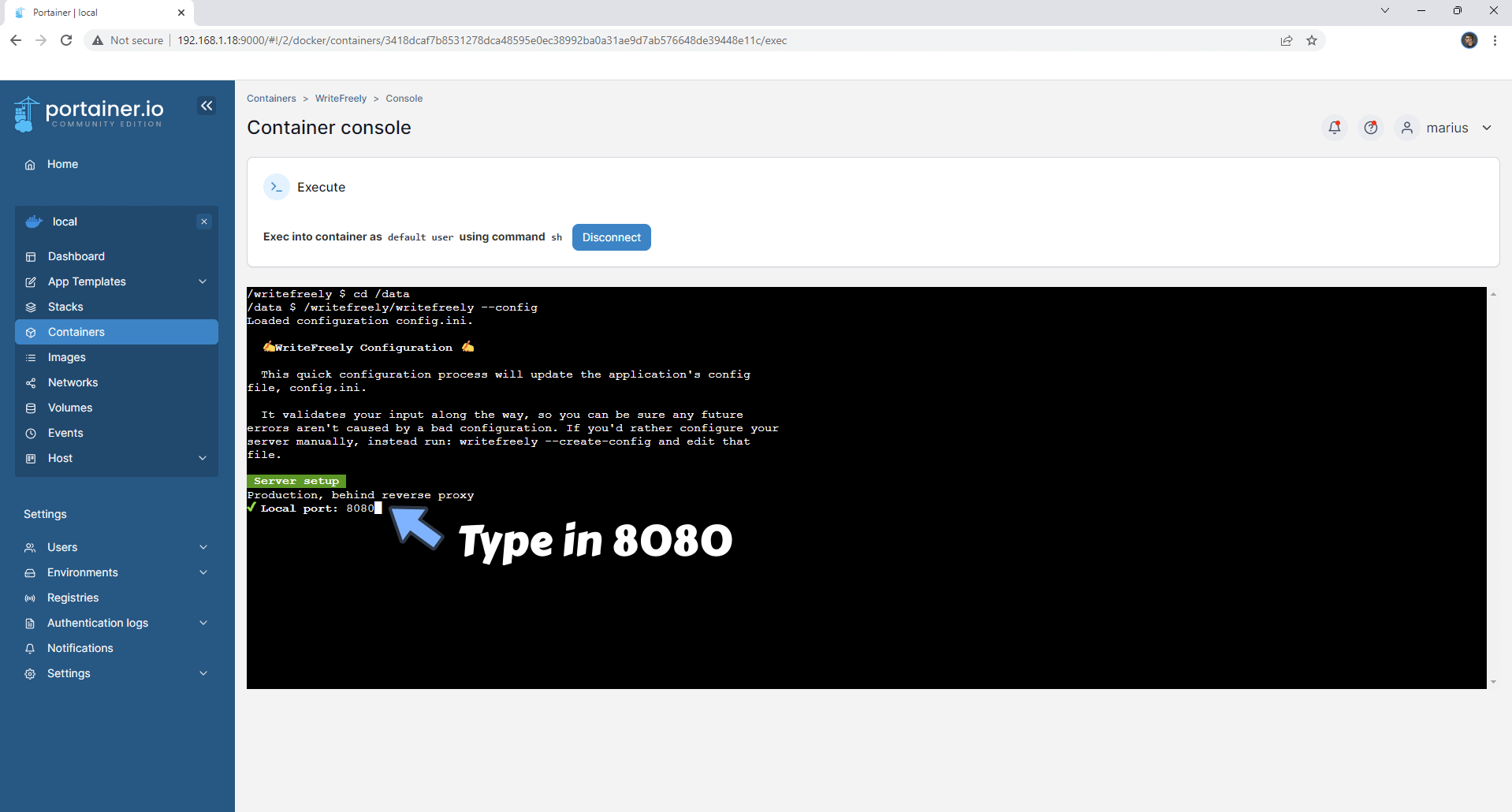
STEP 23
Using the arrow keys on your keyboard select “MySQL” then confirm by pressing Enter on your keyboard. Follow the instructions in the image below.
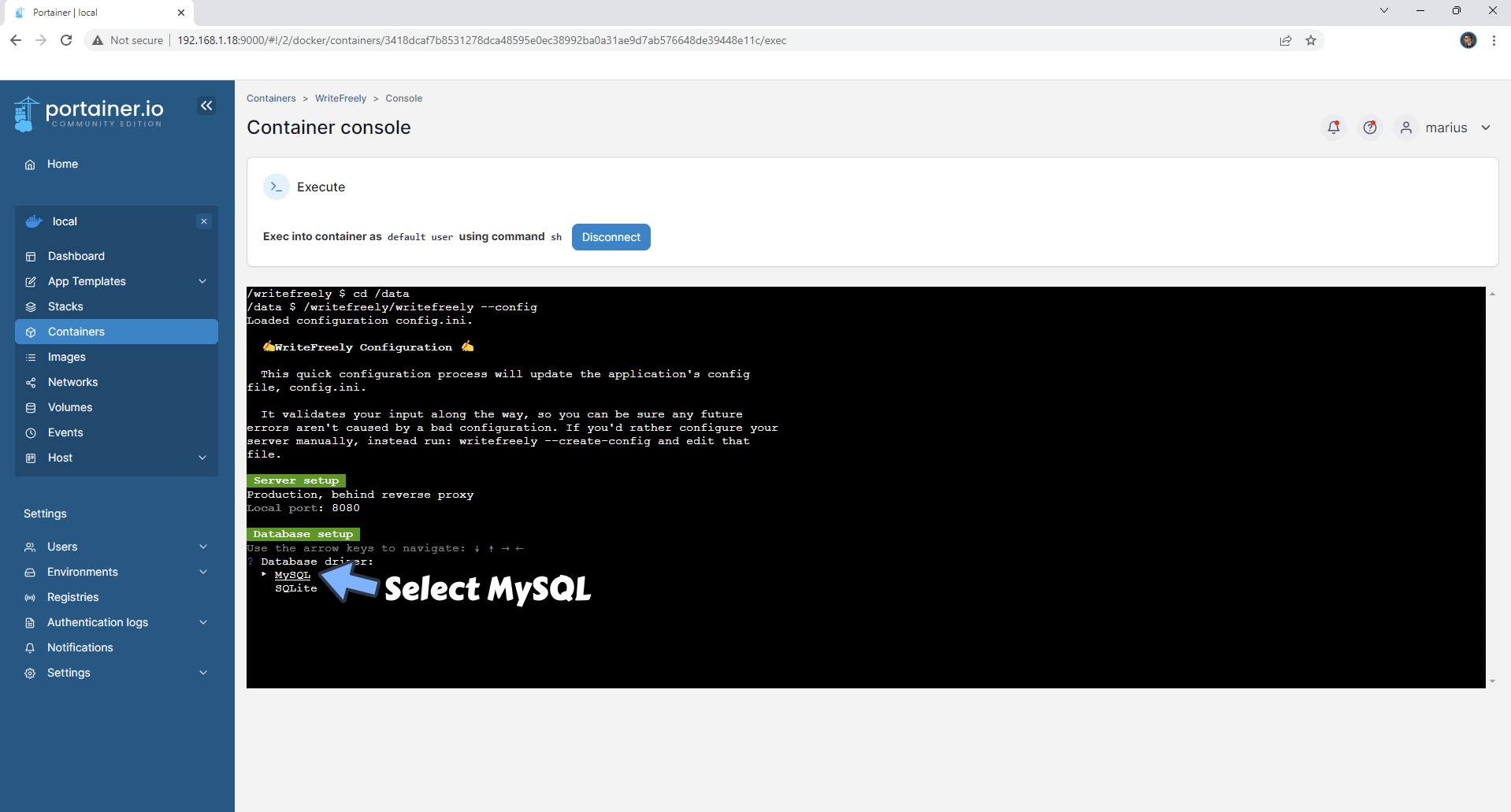
STEP 24
After Selecting MySQL at STEP 23 type in the text below. Confirm by pressing Enter on your keyboard. Follow the instructions in the image below.
writefreelyuser
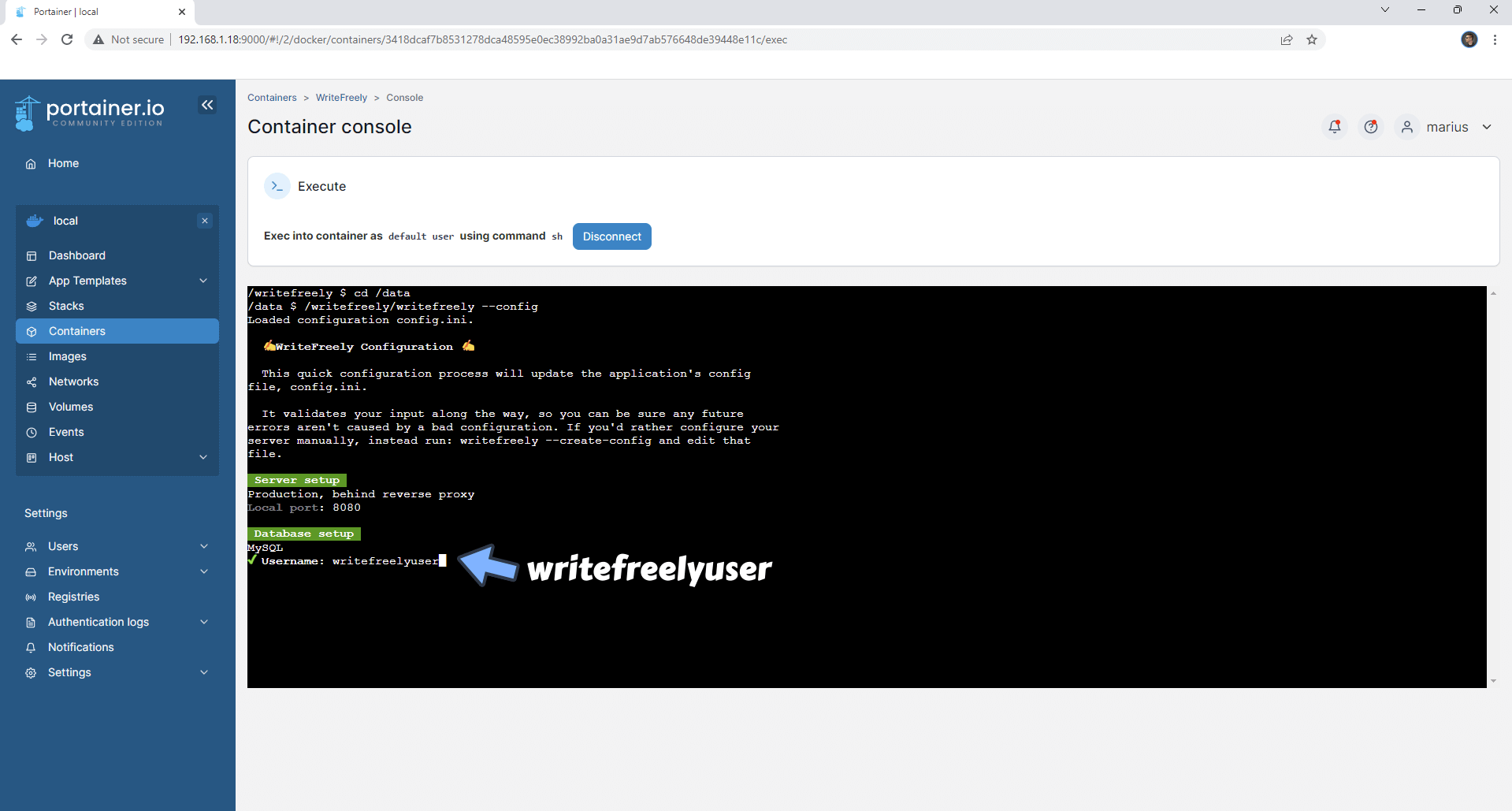
STEP 25
After pressing enter at STEP 24, type in the text below. Confirm by pressing Enter on your keyboard. Follow the instructions in the image below.
writefreelypass
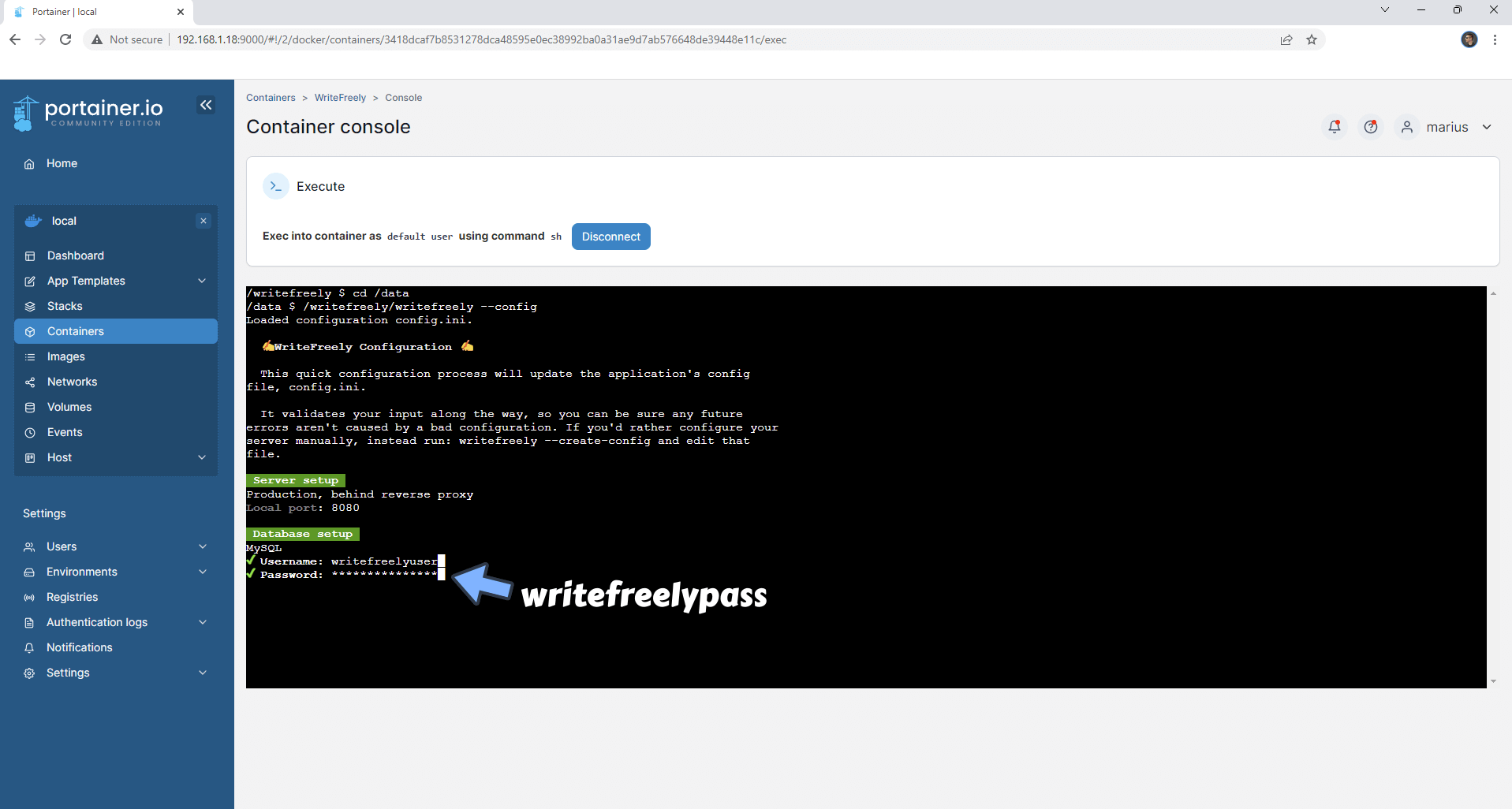
STEP 26
After pressing enter at STEP 25, type in the text below. Confirm by pressing Enter on your keyboard. Follow the instructions in the image below.
writefreely
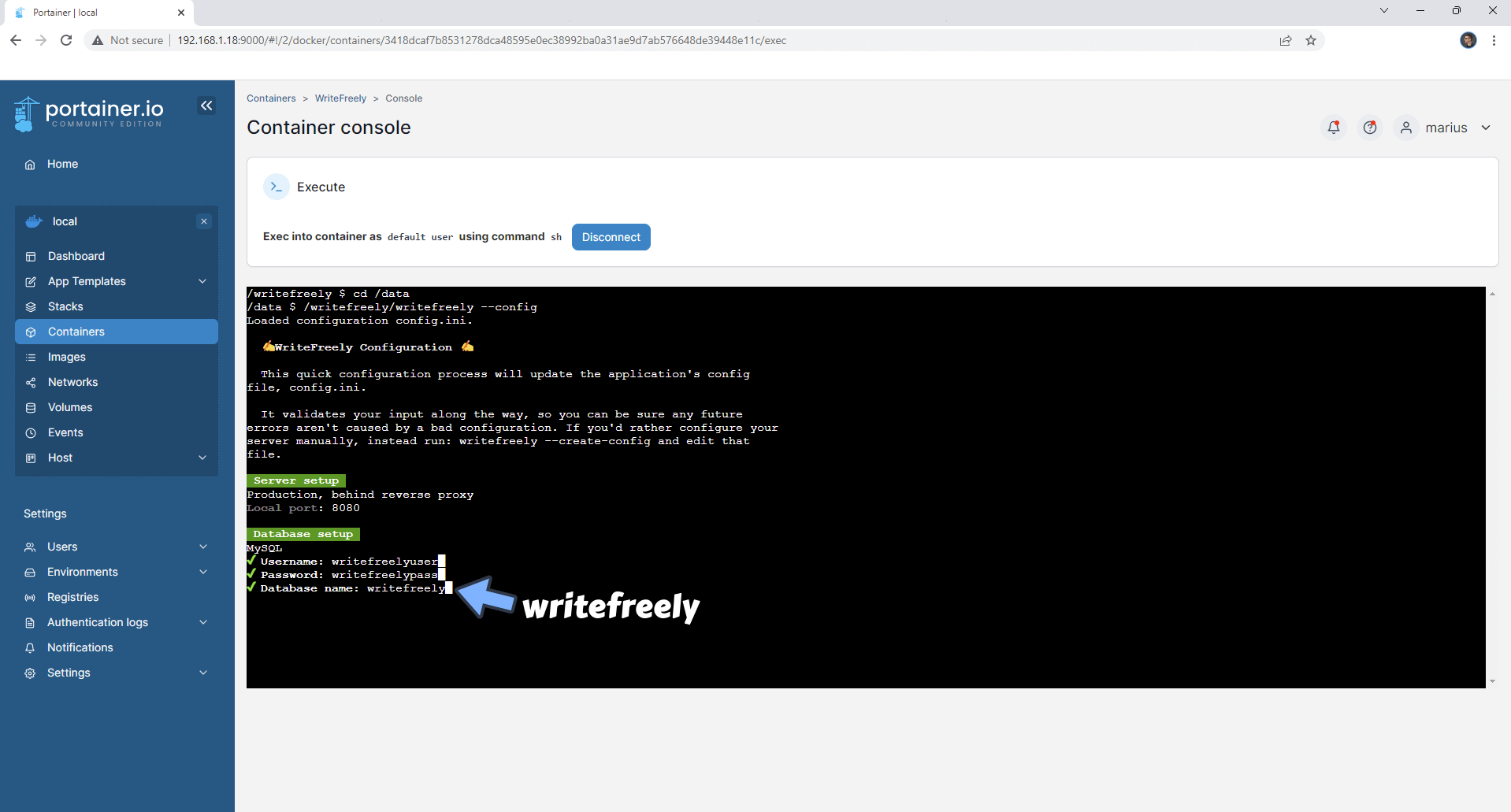
STEP 27
After pressing enter at STEP 26, type in the text below instead of localhost. Confirm by pressing Enter on your keyboard. Follow the instructions in the image below.
writefreely-db

STEP 28
After pressing enter at STEP 27, type in the text below. Confirm by pressing Enter on your keyboard. Follow the instructions in the image below.
3306
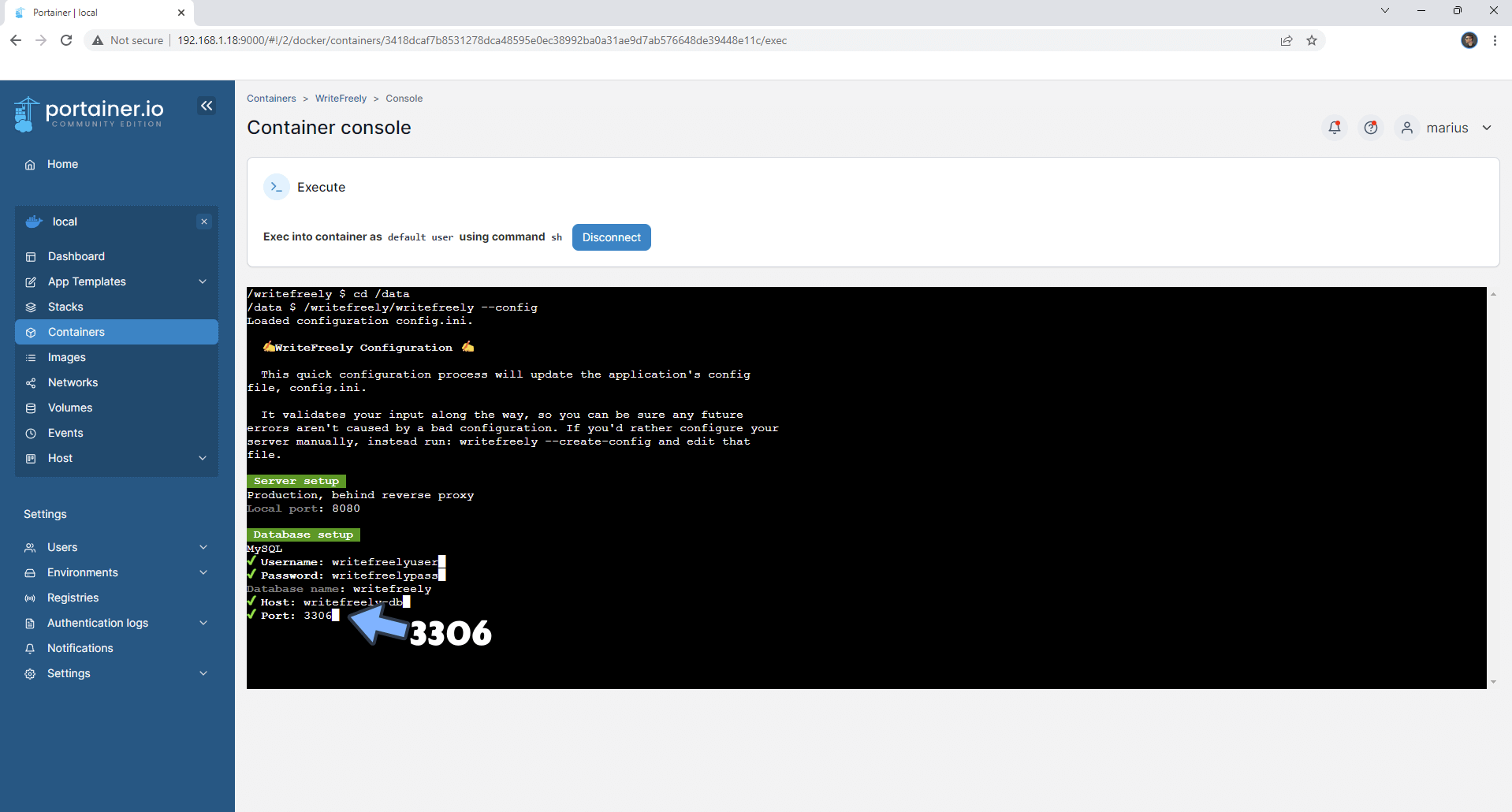
STEP 29
Using the arrow keys on your keyboard select “Single user blog” then confirm by pressing Enter on your keyboard. Follow the instructions in the image below.
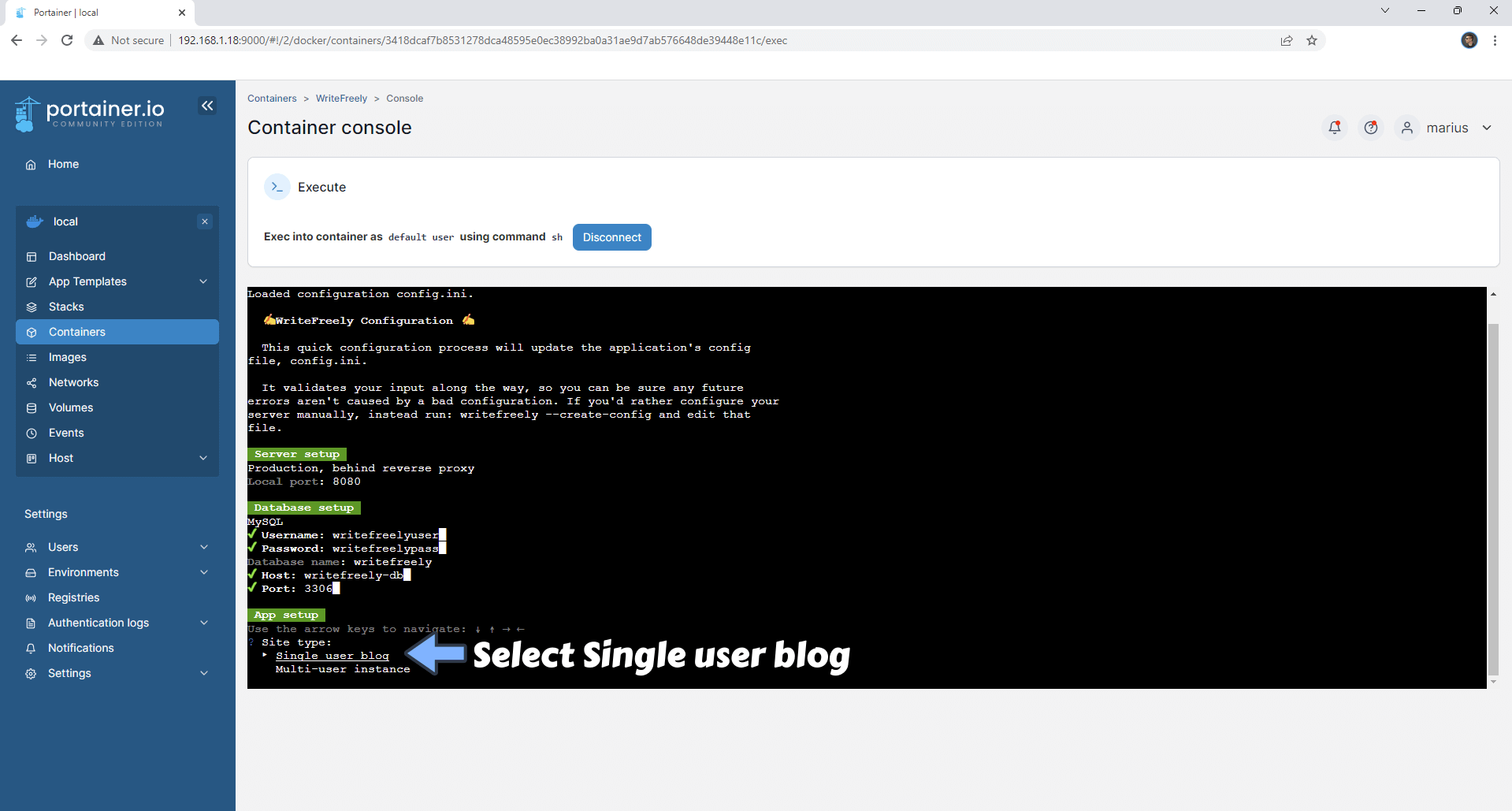
STEP 30
Type in your own Username and confirm by pressing Enter on your keyboard. Follow the instructions in the image below. Note: You will need this Username at STEP 42.
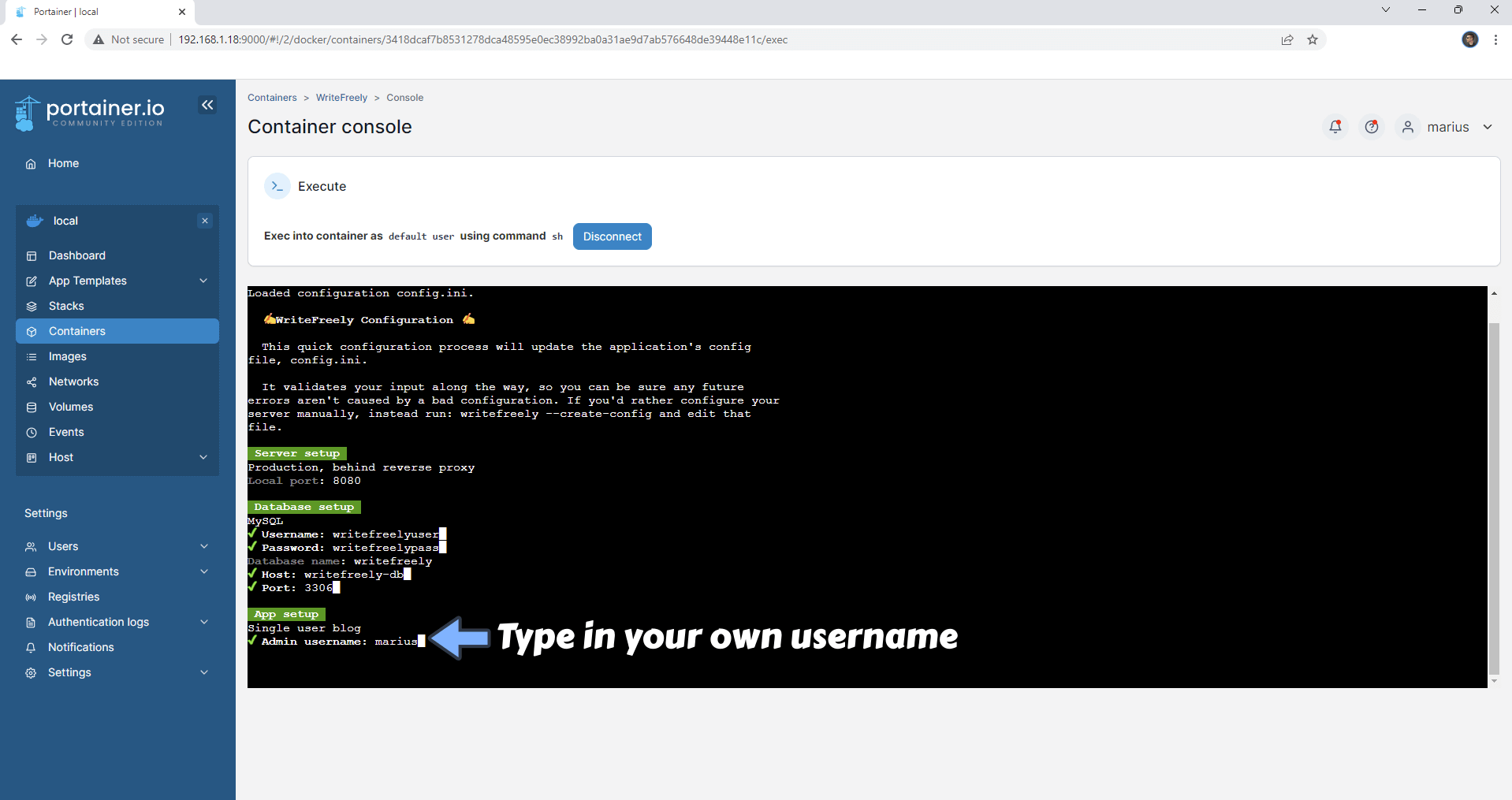
STEP 31
Type in your own Password and confirm by pressing Enter on your keyboard. Follow the instructions in the image below. Note: You will need this Password at STEP 42.
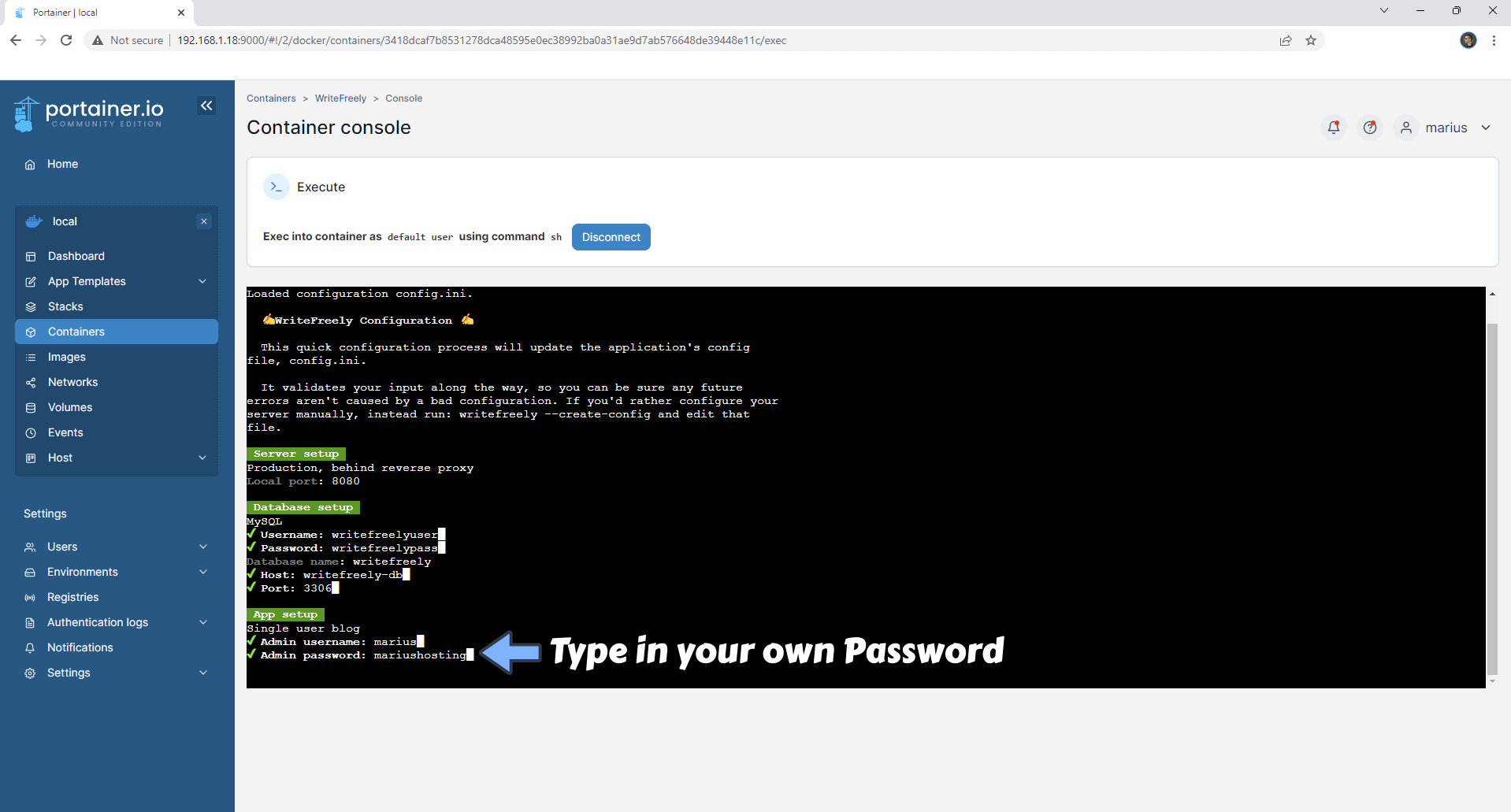
STEP 32
Your blog name should appear automatically. Confirm by pressing Enter on your keyboard. Follow the instructions in the image below.
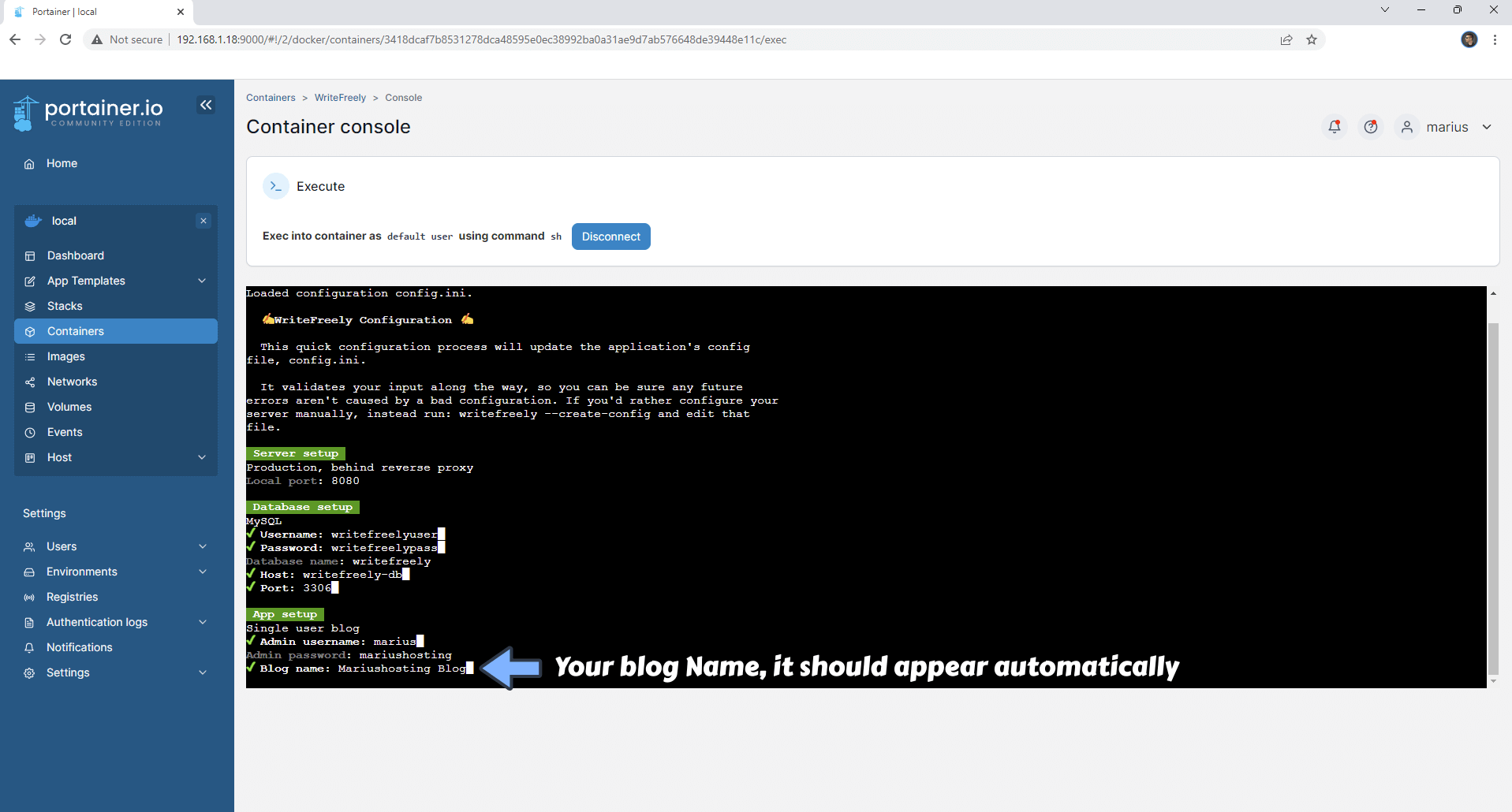
STEP 33
Your DDNS Address should appear automatically. Confirm by pressing Enter on your keyboard. Follow the instructions in the image below.
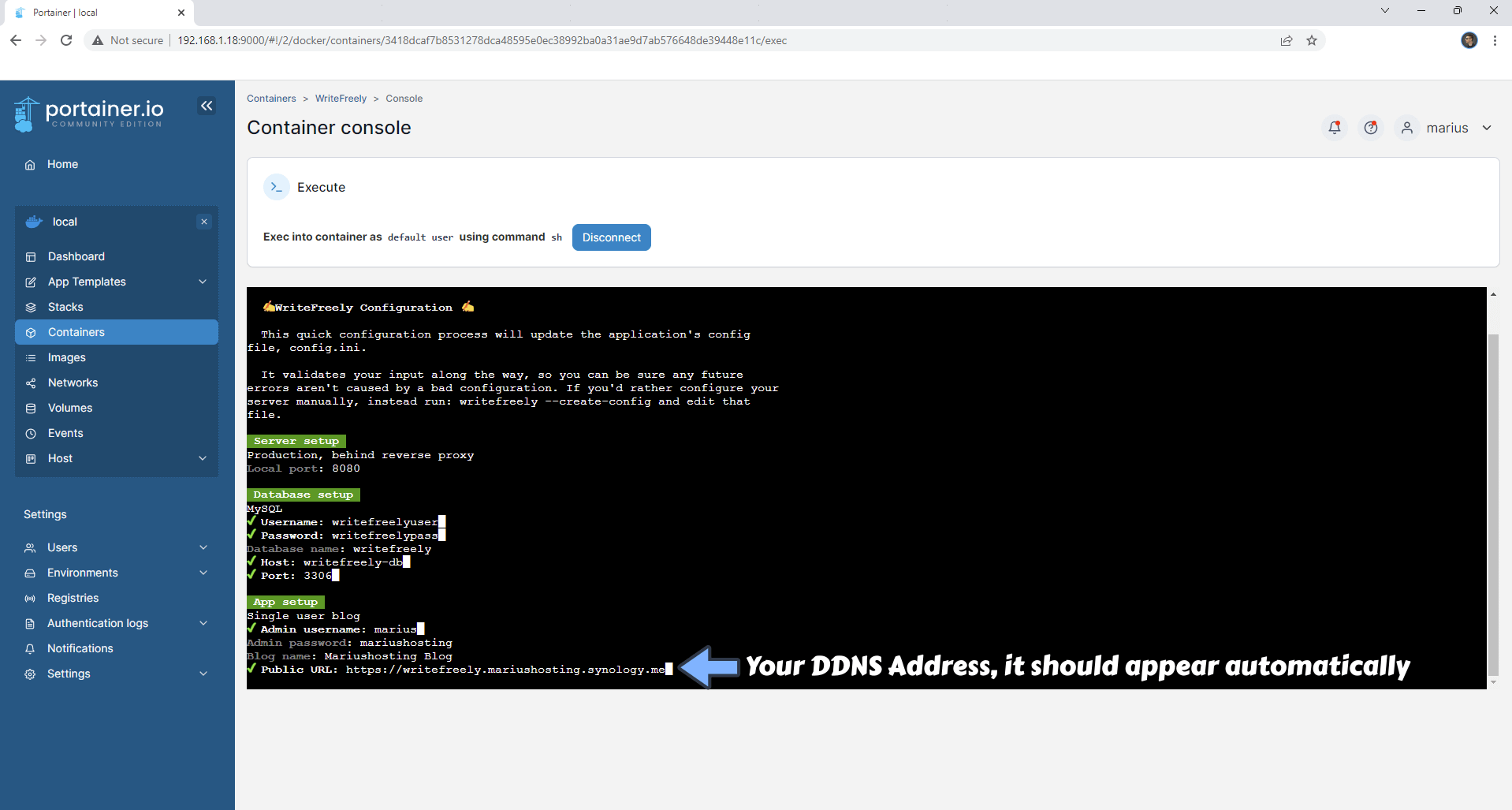
STEP 34
Select to Enable or Disable Federation. I chose Enabled. Confirm by pressing Enter on your keyboard. Follow the instructions in the image below.
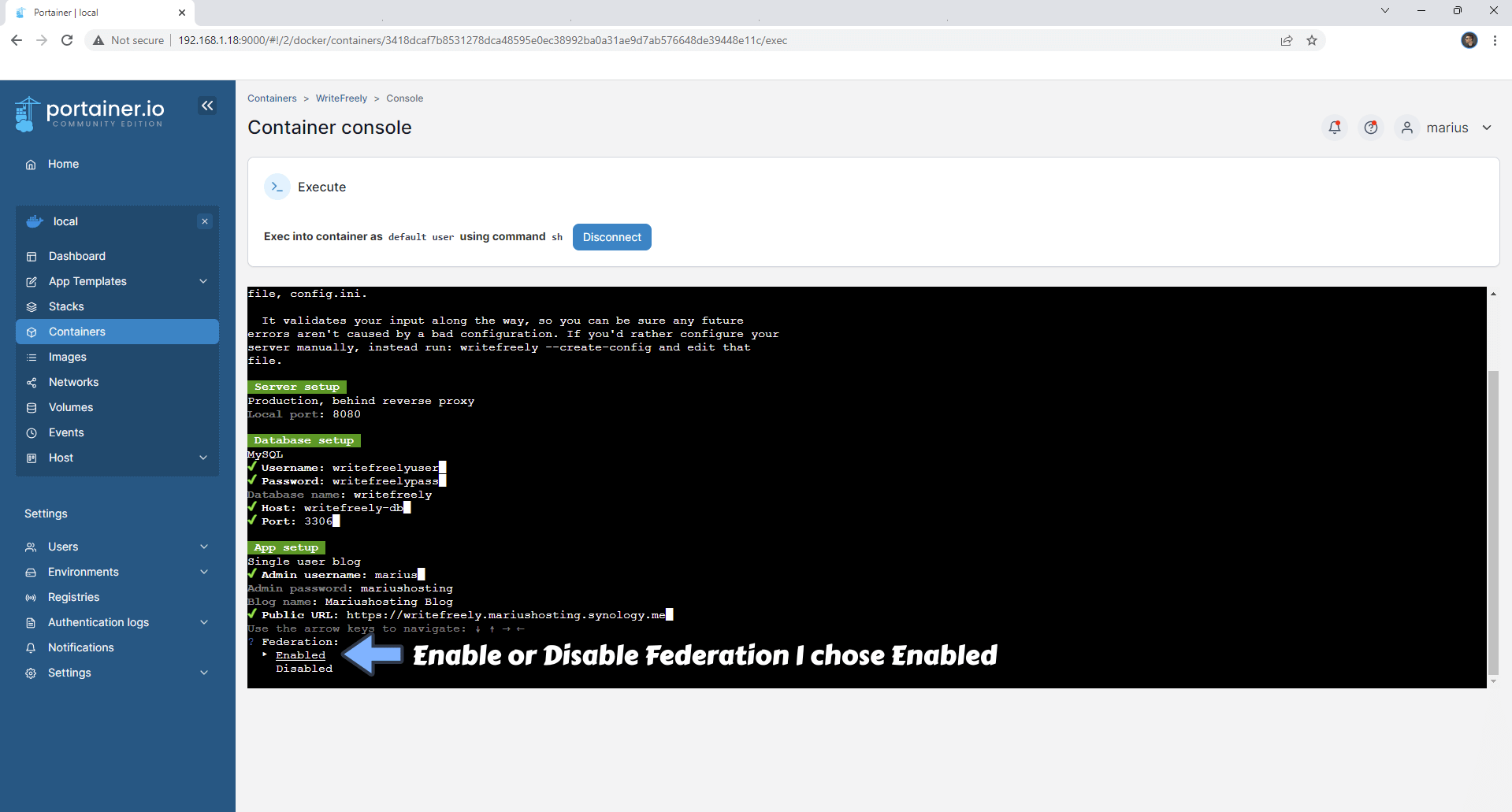
STEP 35
Select Public for usage stats. This depends on your needs. I chose Public. Confirm by pressing Enter on your keyboard. Follow the instructions in the image below.
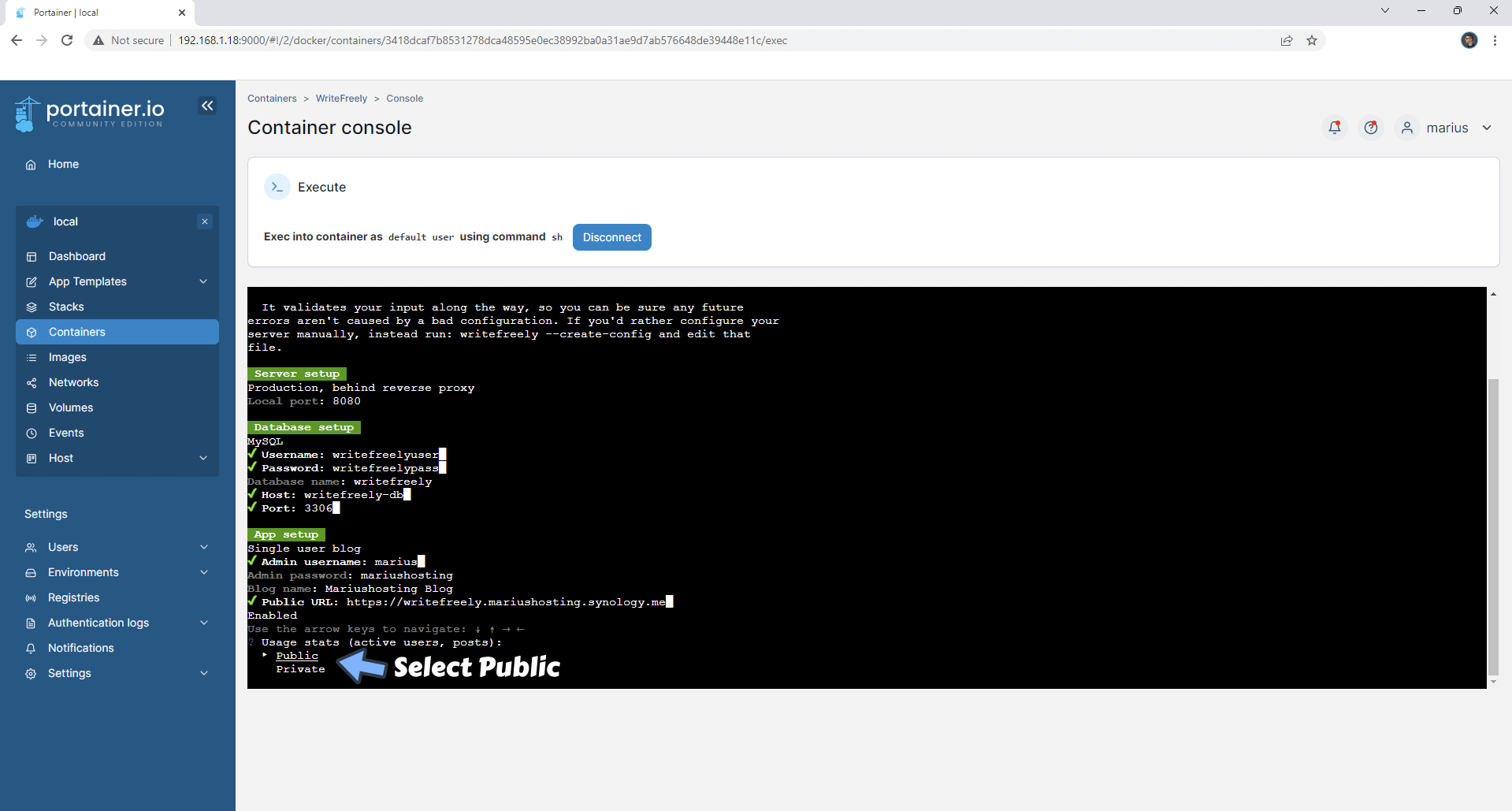
STEP 36
Select Public for metadata privacy. This depends on your needs. I chose Public. Confirm by pressing Enter on your keyboard. Follow the instructions in the image below.
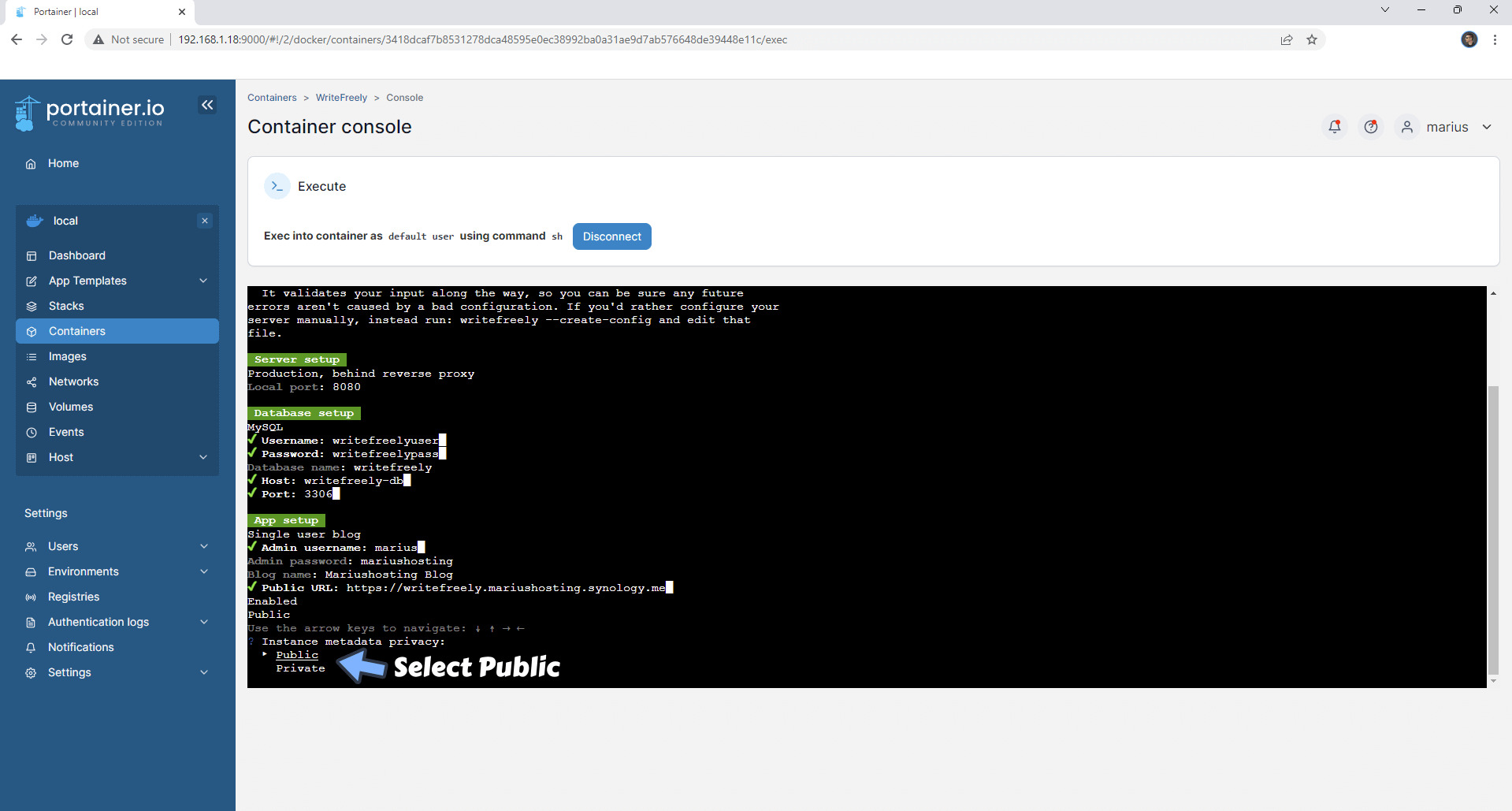
STEP 37
Done. The MySQL database will be written.
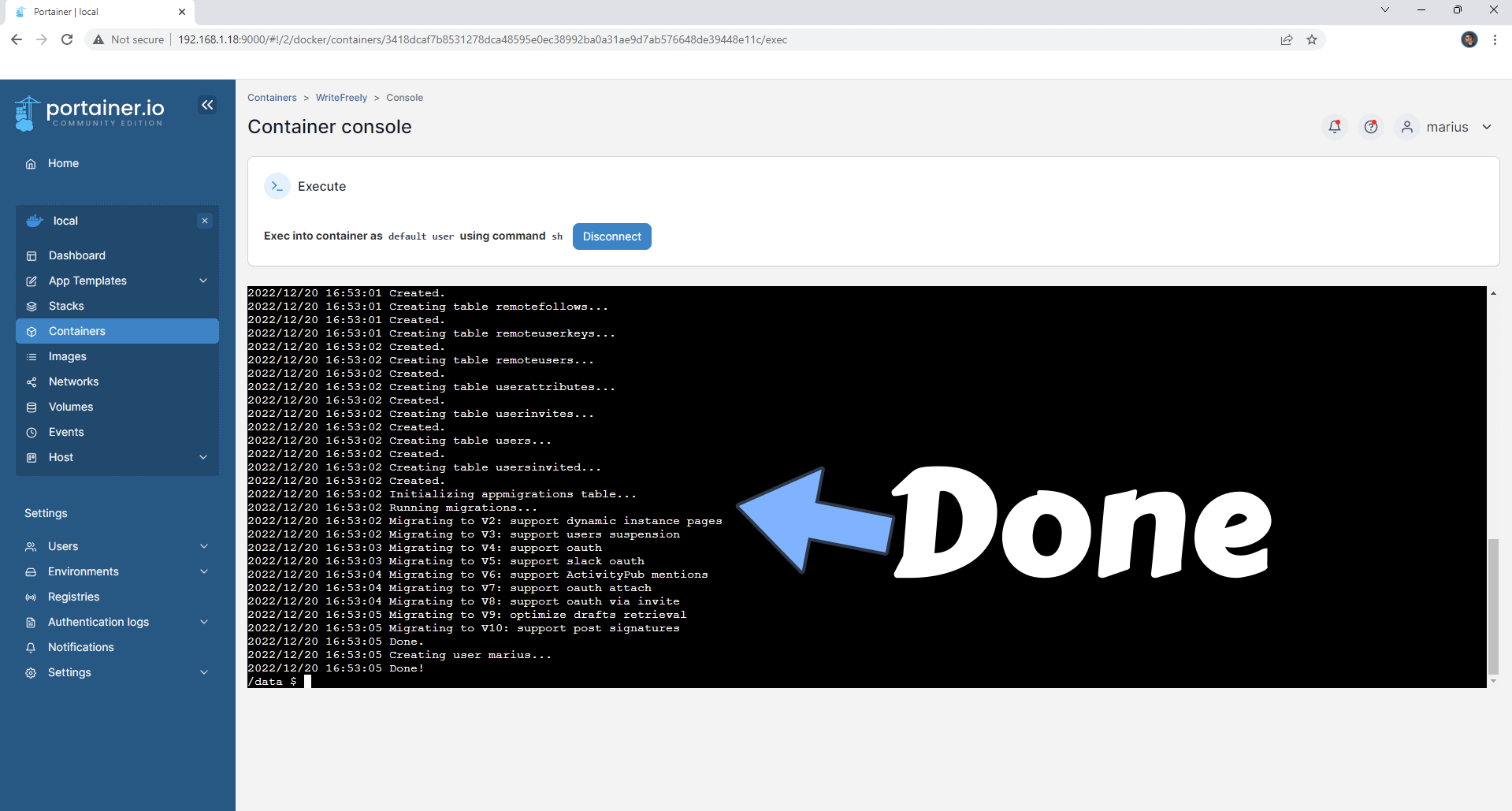
STEP 38
🟢Please Support My work by Making a Donation. Almost 99,9% of the people that install something using my guides forget to support my work, or just ignore STEP 1. I’ve been very honest about this aspect of my work since the beginning: I don’t run any ADS, I don’t require subscriptions, paid or otherwise, I don’t collect IPs, emails, and I don’t have any referral links from Amazon or other merchants. I also don’t have any POP-UPs or COOKIES. I have repeatedly been told over the years how much I have contributed to the community. It’s something I love doing and have been honest about my passion since the beginning. But I also Need The Community to Support me Back to be able to continue doing this work.
STEP 39
On the left sidebar in Portainer, click Containers. Identify your WriteFreely instance, select it then click Restart. Follow the instructions in the image below.
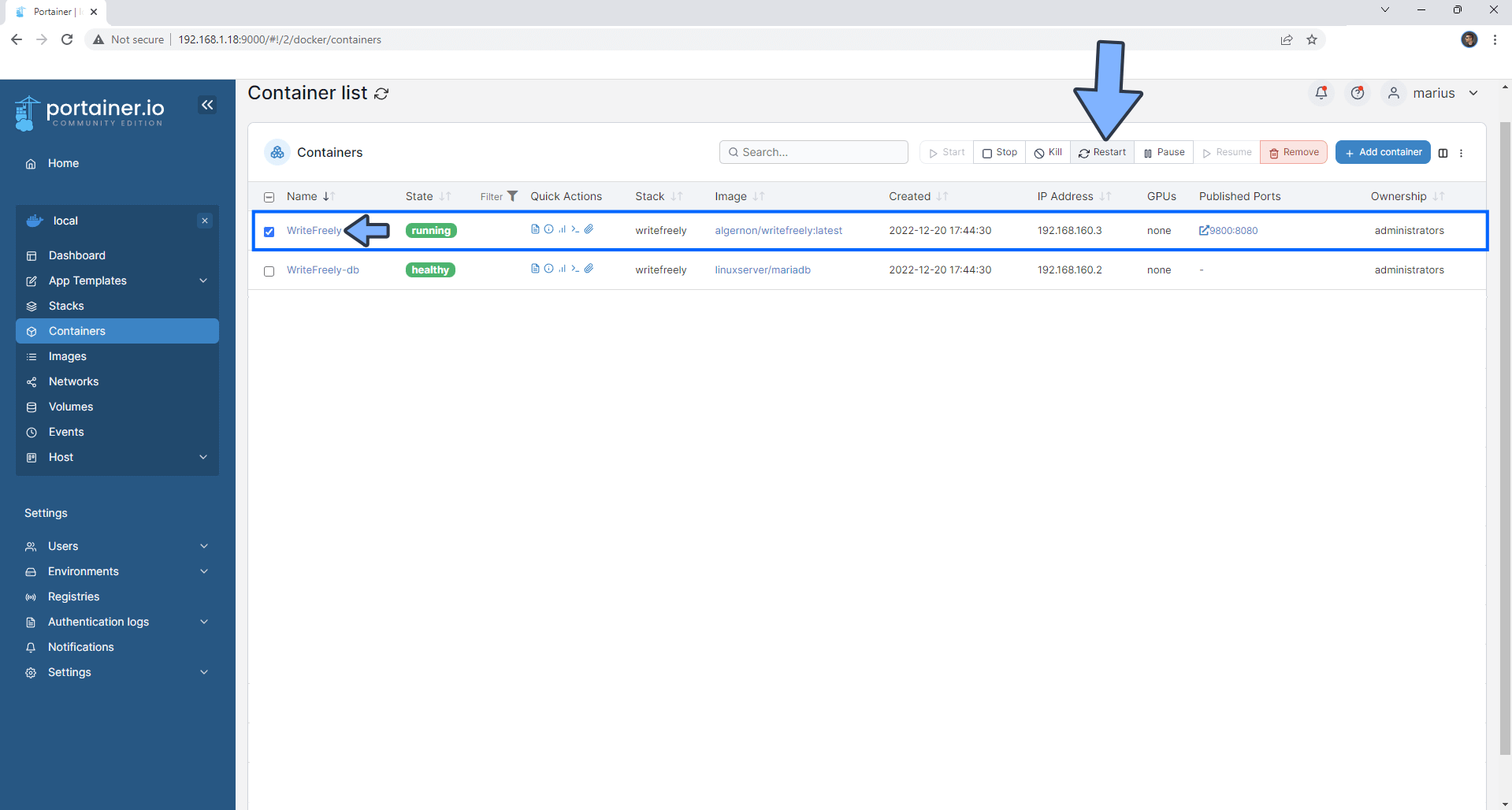
STEP 40
🟢Please Support My work by Making a Donation. Almost 99,9% of the people that install something using my guides forget to support my work, or just ignore STEP 1. I’ve been very honest about this aspect of my work since the beginning: I don’t run any ADS, I don’t require subscriptions, paid or otherwise, I don’t collect IPs, emails, and I don’t have any referral links from Amazon or other merchants. I also don’t have any POP-UPs or COOKIES. I have repeatedly been told over the years how much I have contributed to the community. It’s something I love doing and have been honest about my passion since the beginning. But I also Need The Community to Support me Back to be able to continue doing this work.
STEP 41
Now open your browser and type in your HTTPS/SSL certificate like this https://writefreely.yourname.synology.me that you have previously created at STEP 7. In my case it’s https://writefreely.mariushosting.synology.me If everything goes right, you will see the main WriteFreely page. At the top left click on the Menu then Log in. Follow the instructions in the image below.
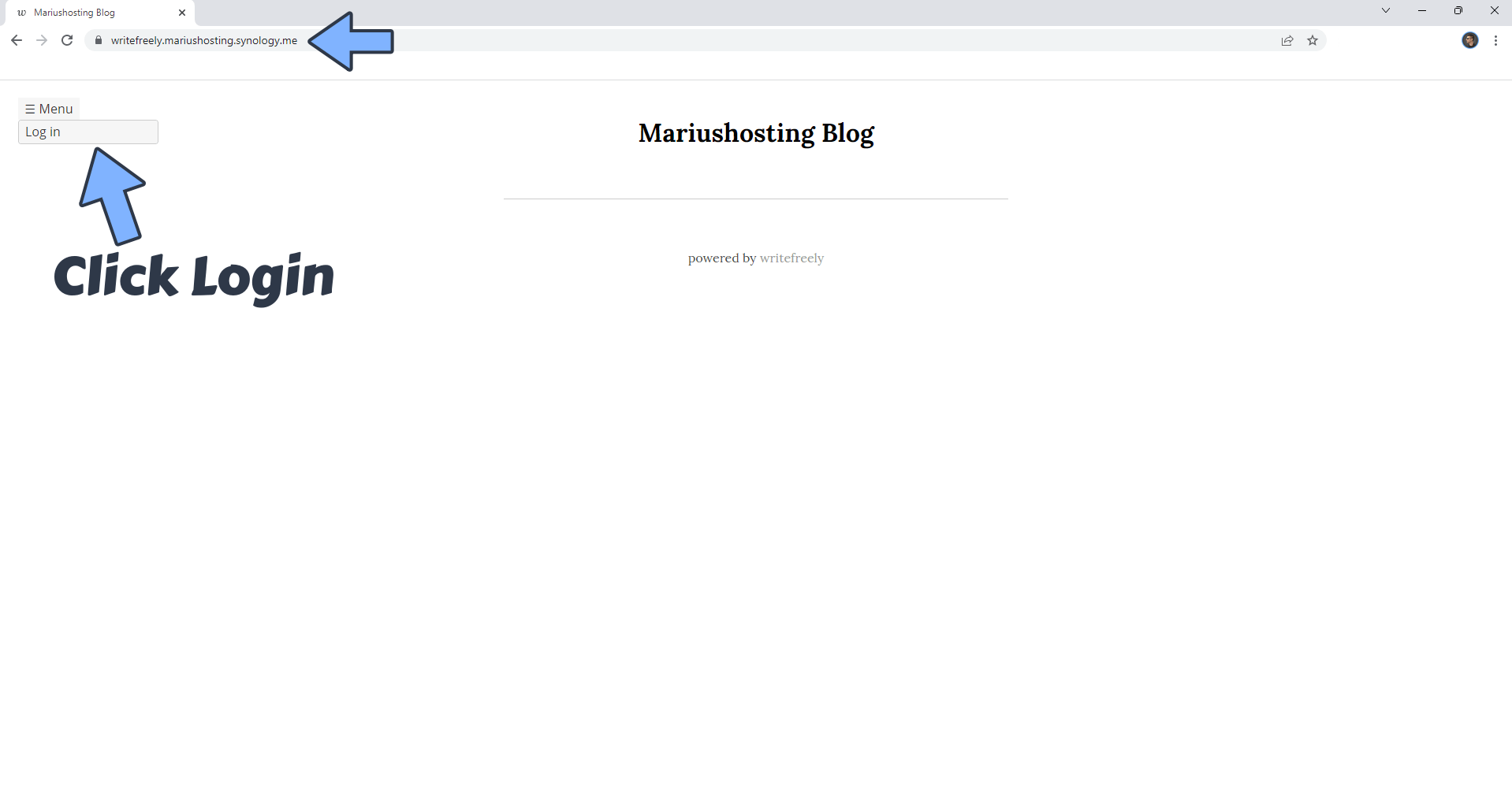
STEP 42
Type in your own Username and your own Password that you have created at STEP 30 and STEP 31, respectively. Click Login. Follow the instructions in the image below.
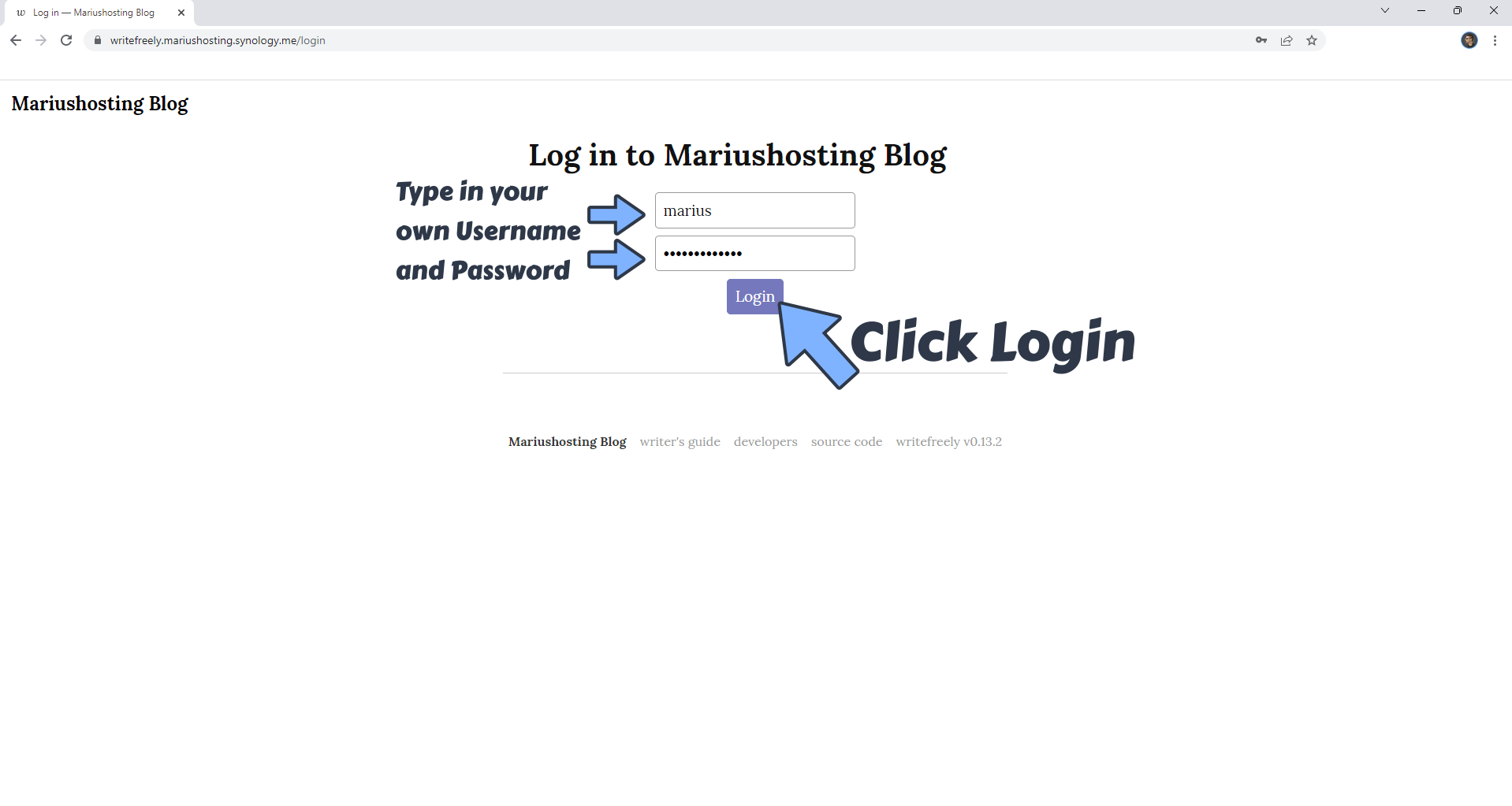
You can start to write on your WriteFreely blog!
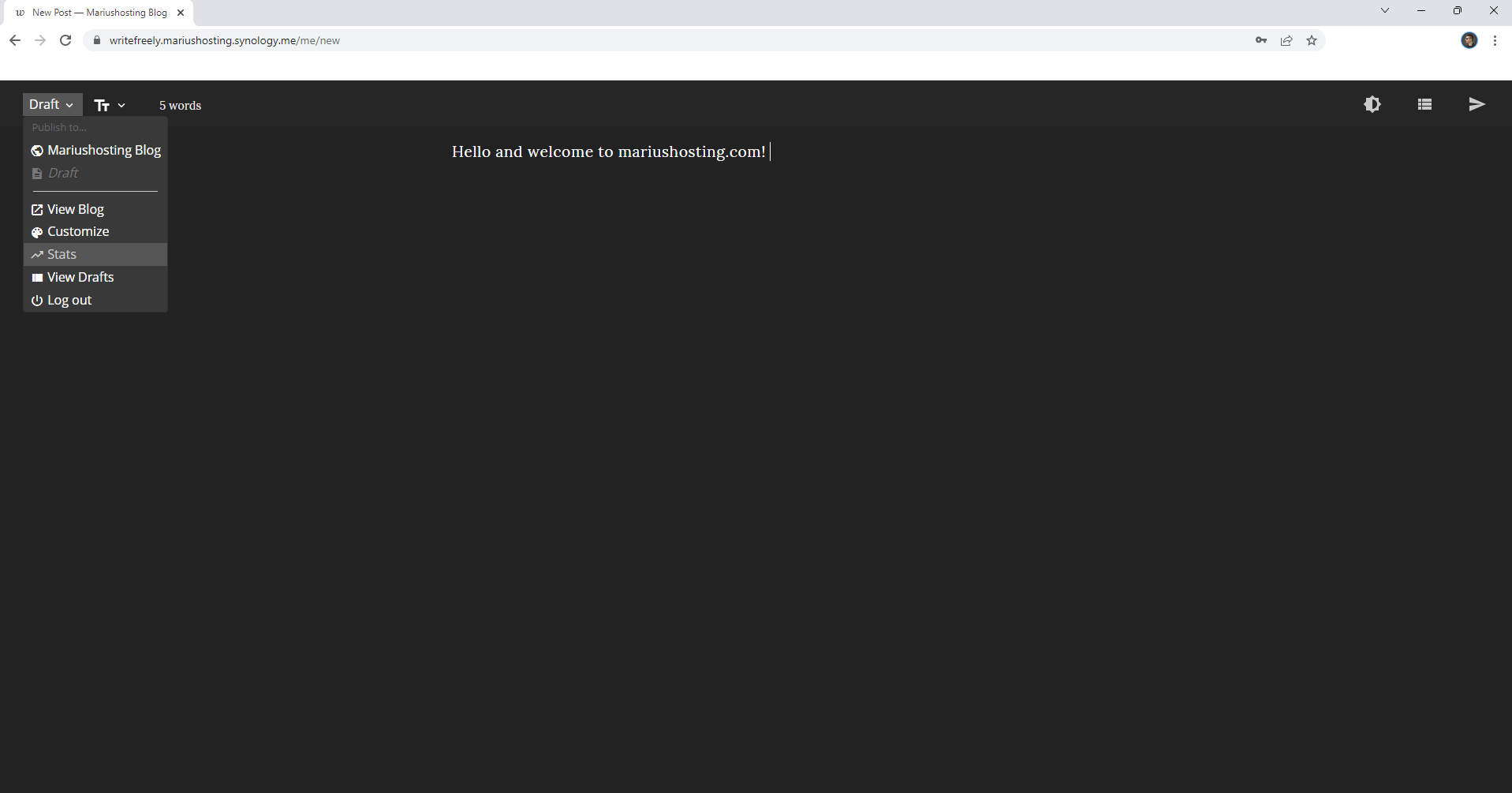
STEP 43
If you need to modify something in the configuration of your WriteFreely, like opening user registration to all or preventing new user registration, or enabling or disabling federation, you can do it by going to the data folder that you have previously created at STEP 12 and opening the config.ini file. Note: to be able to open the config.ini file, you need to have installed Synology Text Editor on your NAS as per instructions at STEP 4.
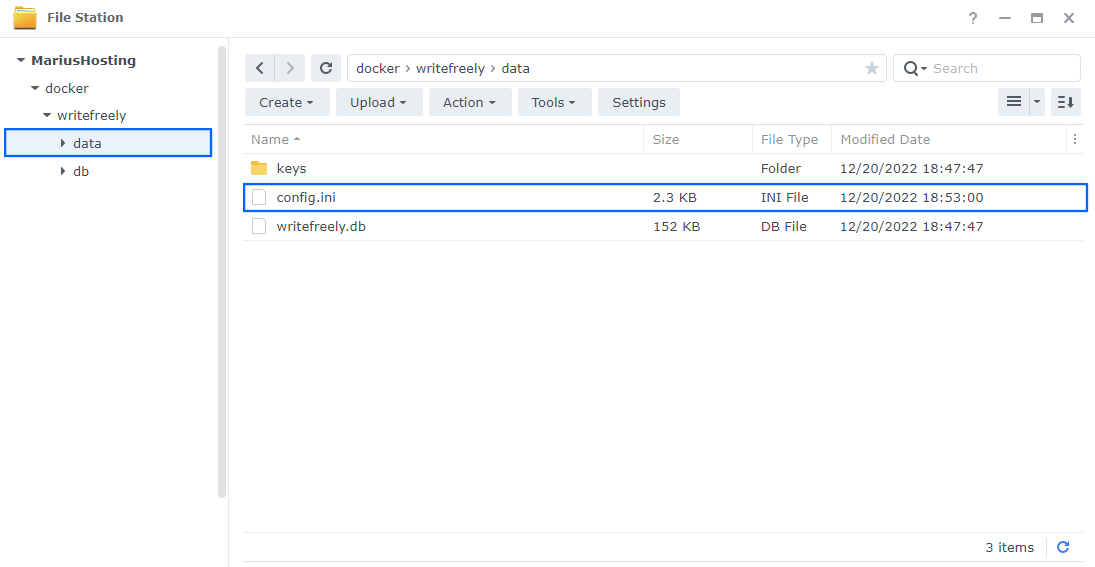
Apply the changes you want, then save the file. Note: After you save the config.ini file, remember to restart the WriteFreely container like you did at STEP 39 to apply the changes.
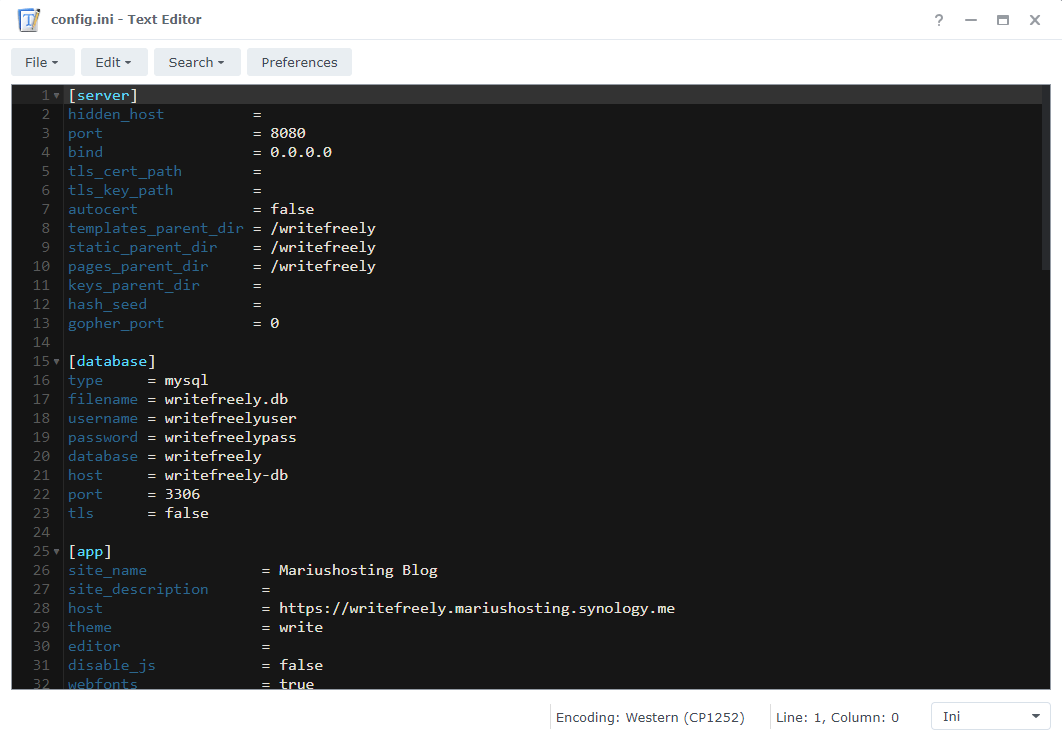
Enjoy WriteFreely with MySQL!
If you encounter issues by using this container, make sure to check out the Common Docker issues article.
Note: Find out how to update the WriteFreely container with the latest image.
Note: How to Back Up Docker Containers on your Synology NAS.
Note: Can I run Docker on my Synology NAS? See the supported models.
Note: How to Free Disk Space on Your NAS if You Run Docker.
Note: How to Schedule Start & Stop For Docker Containers.
Note: How to Activate Email Notifications.
Note: How to Add Access Control Profile on Your NAS.
Note: How to Change Docker Containers Restart Policy.
Note: How to Use Docker Containers With VPN.
Note: Convert Docker Run Into Docker Compose.
Note: How to Clean Docker.
Note: How to Clean Docker Automatically.
Note: Best Practices When Using Docker and DDNS.
Note: Some Docker Containers Need WebSocket.
Note: Find out the Best NAS Models For Docker.
Note: Activate Gmail SMTP For Docker Containers.
This post was updated on Tuesday / May 27th, 2025 at 1:28 PM
